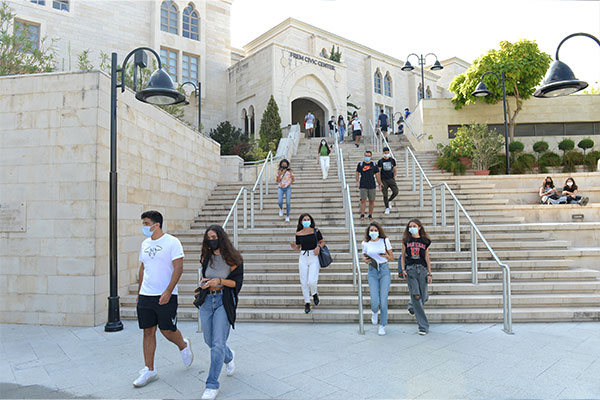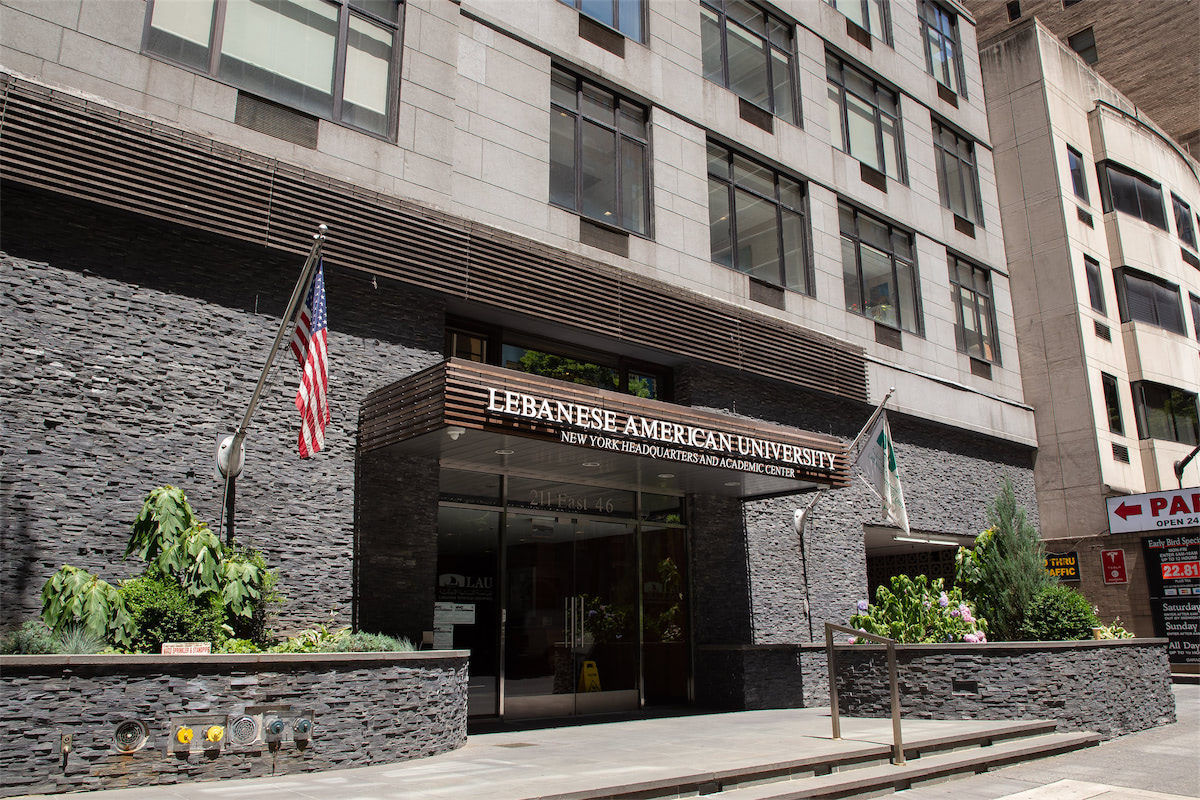LAU is born as the American Junior College for Women (AJCW), headed by the 29-year-old missionary Frances Pryor Irwin as its first principal.
Historical Timeline
Founded nearly two decades before Lebanon’s independence, LAU has enjoyed long periods of development that were punctuated by surrounding economic and sociopolitical upheaval.
In these distressing times, we look back at our past to see that LAU has not only overcome adversity time and again, but it has emerged as an enduring, dynamic, solution-oriented organization for tomorrow. Its history speaks of a remarkable spirit of service that held up across the generations, even in the face of destruction and chaos.
Looking beyond, as the pace of change accelerates and new generations grapple with daunting global problems, we have set out to define what the university can offer next, as the innovating, empowering, ever-giving force it has always been.
1924
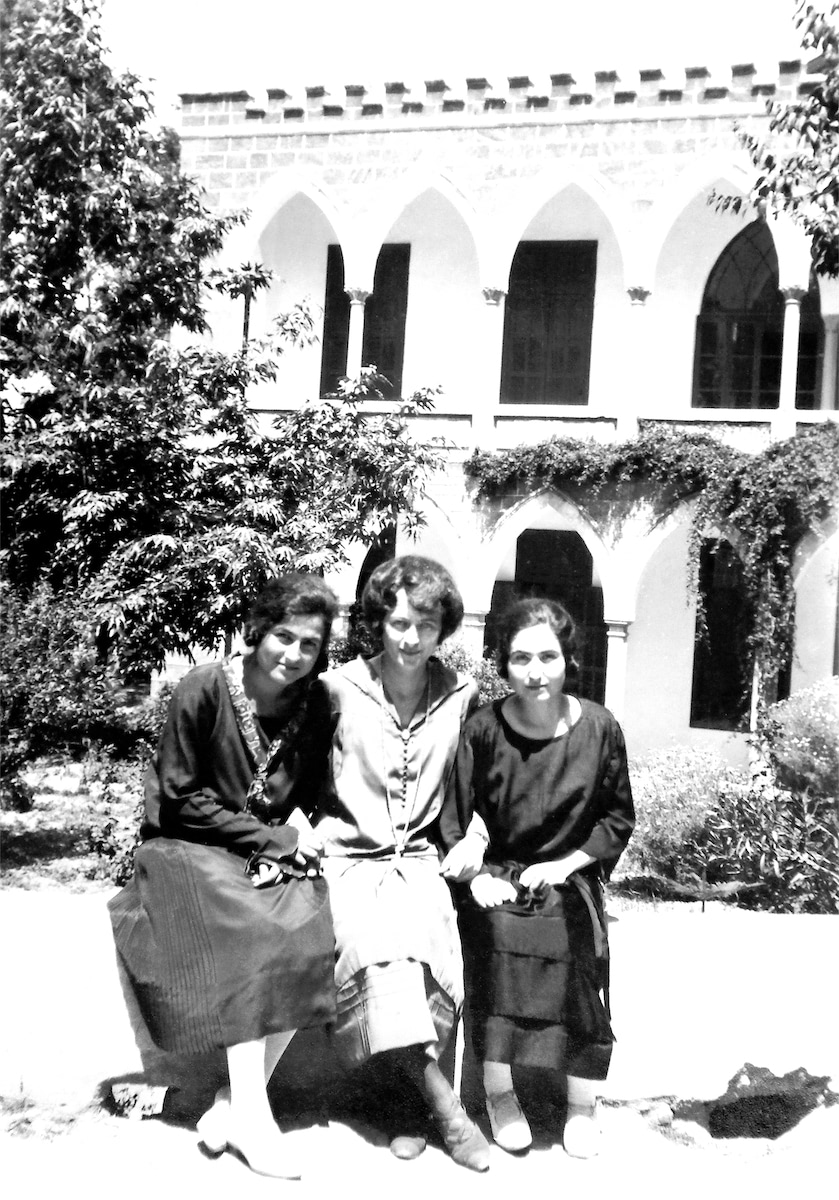
![[Photo]](https://100.lau.edu.lb/images/ajc-irwin-with-students-1924-opt.jpg)
1926
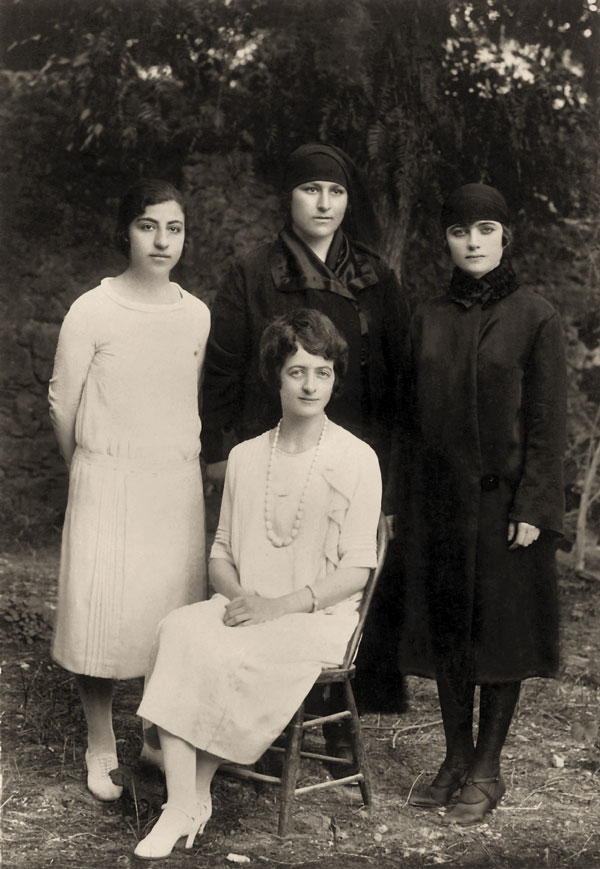
![[Photo]](https://100.lau.edu.lb/images/1926-ajc-first-graduates-habboub-barbir-mughriditchian-with-ajcws-first-principal.jpg)
AJCW graduates its first cohort who go on to become pioneers in their own right: Munira Barbir Naamani, Saniya Habboub al-Naqqash and Armenouhi Der Mugrditchian. Habboub al-Naqqash becomes the first female doctor to practice in Beirut and Mugrditchian founds a maternity hospital in Homs.
1932
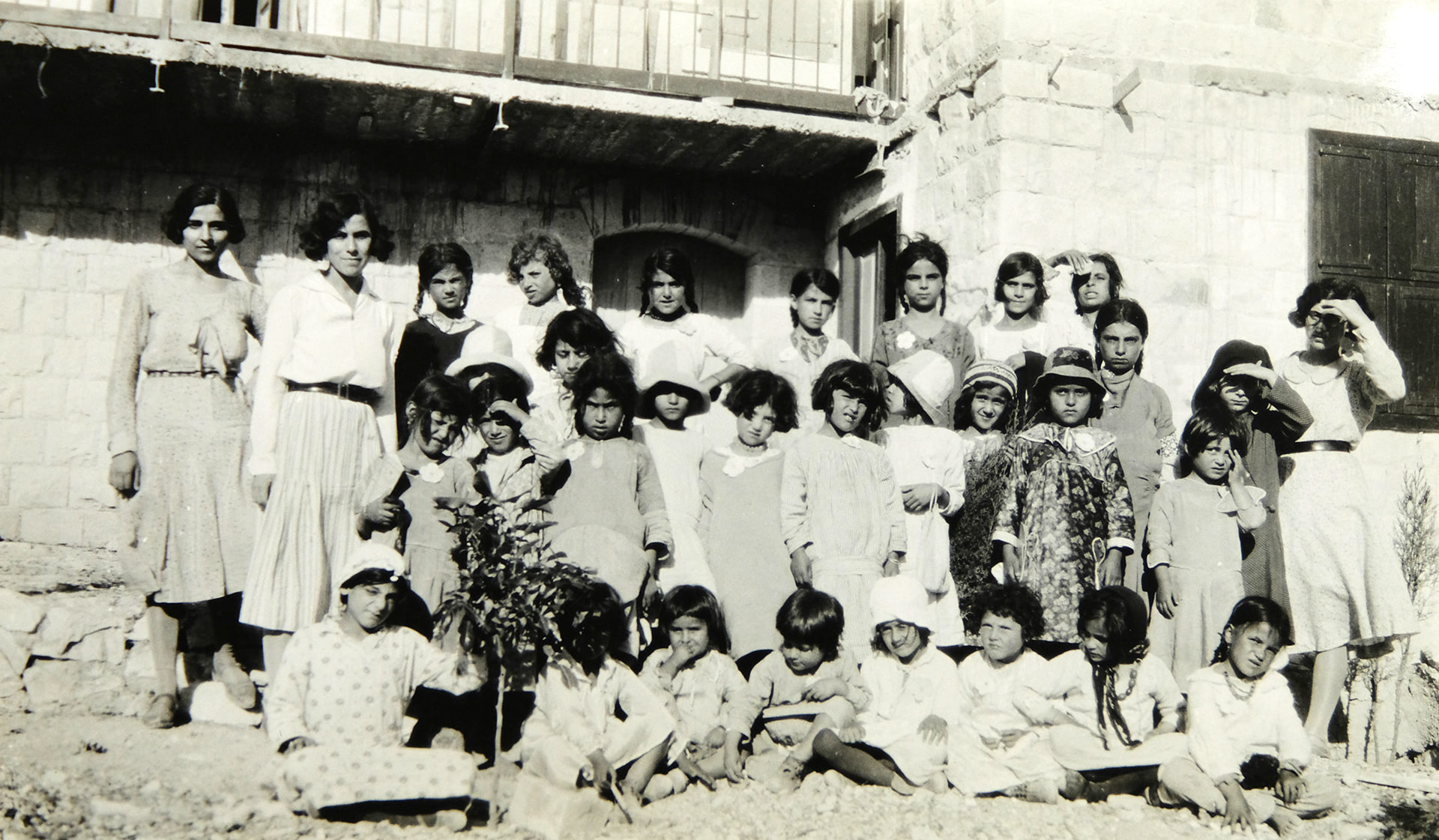
![[Photo]](https://100.lau.edu.lb/images/ajc-teachers-bint-jbeil-1934-opt.jpg)
Irwin’s associate and teacher Winifred Shannon establishes the Village Welfare Camp, the first social service program by an institution of higher learning in the region. During the five to six-week camp, students—all women—live in tents set up in the vicinity of remote villages to serve the educational and health needs of their communities.
1935
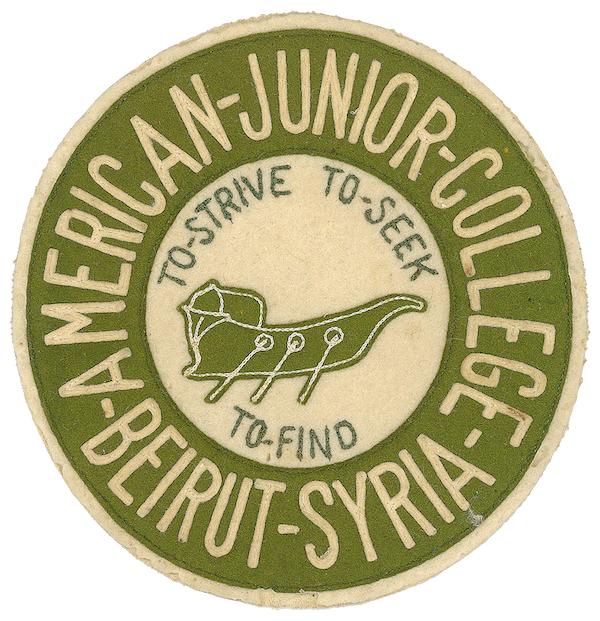
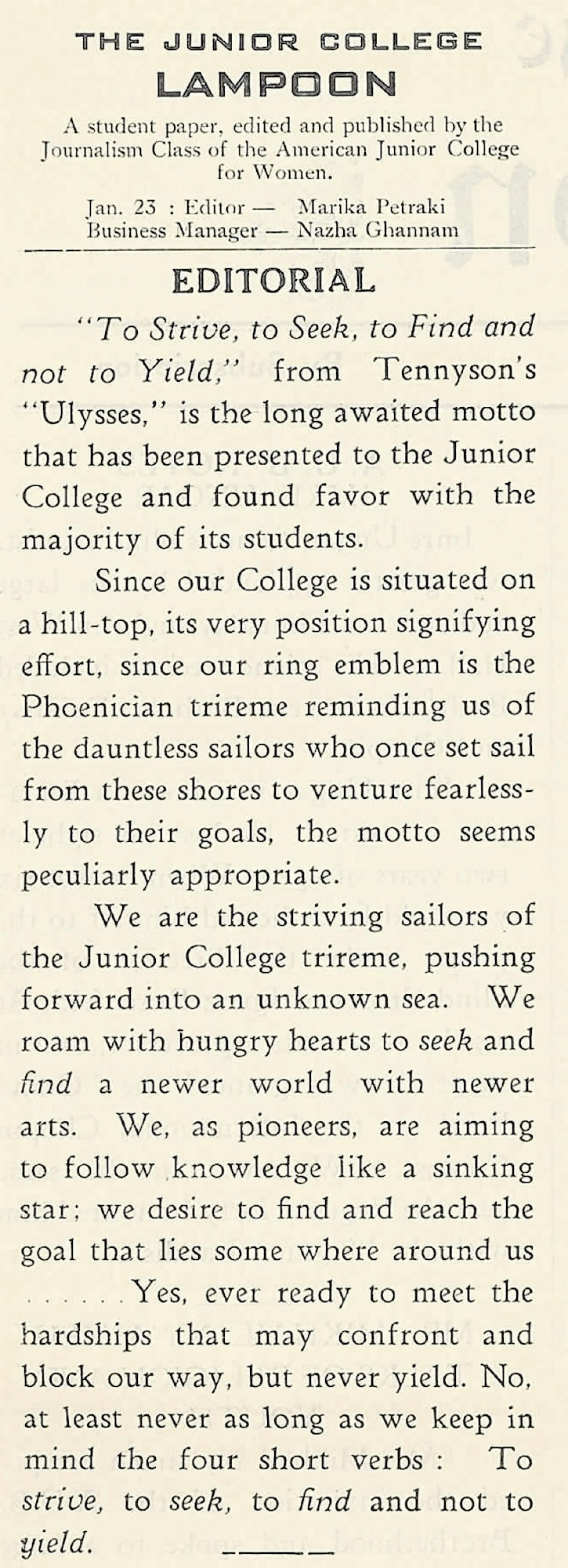
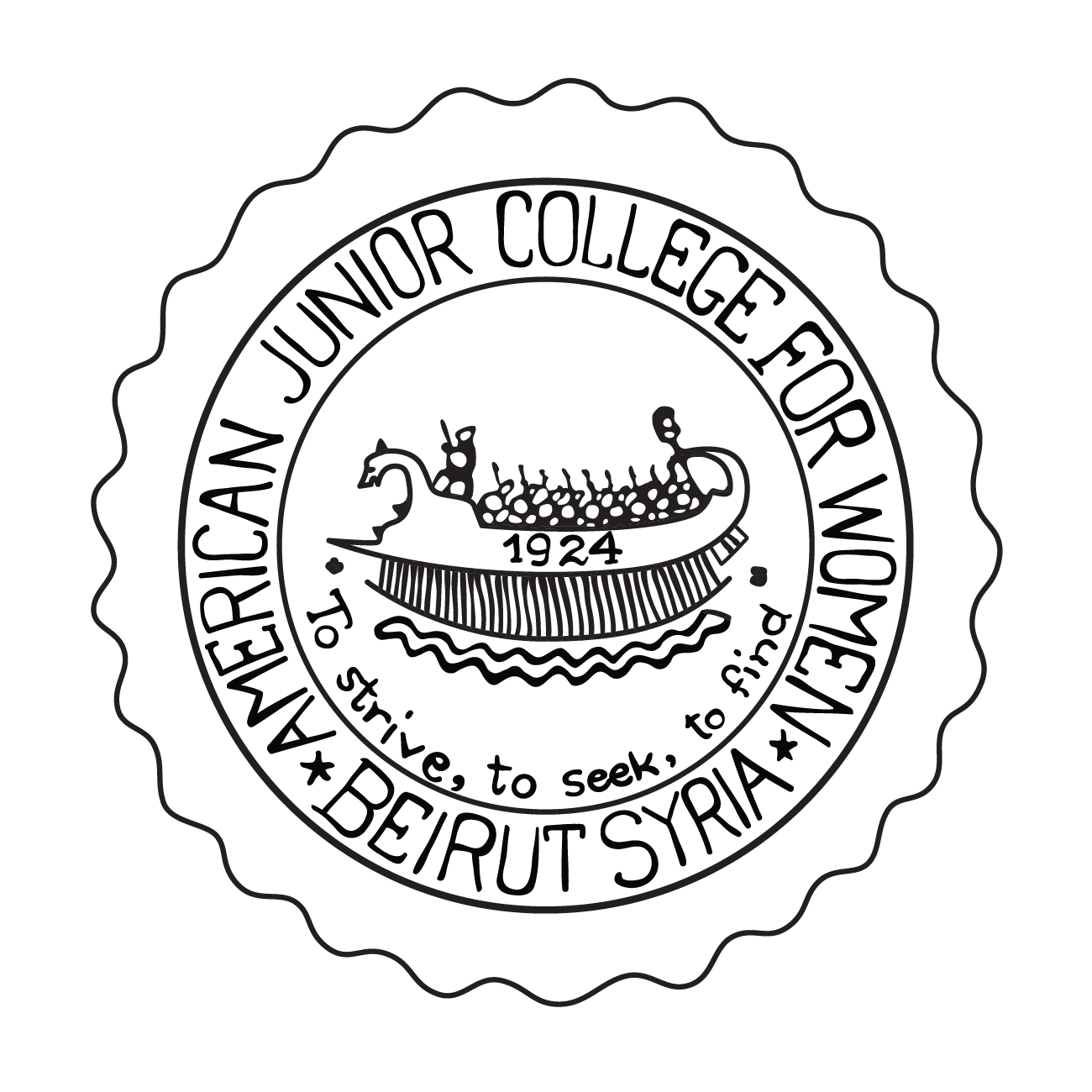
![[Photo]](https://100.lau.edu.lb/images/_1935-mobile.png)
AJCW becomes the first institution in the region to introduce a journalism class, created by Winifred Shannon. In this class, freshman student Elizabeth Kuenzler Marshall wins the competition to design the college’s motto and seal. The motto, “To strive, to seek, to find, and not to yield,” is borrowed from Alfred Lord Tennyson’s poem “Ulysses,” and the seal depicting the Phoenician trireme symbolizes technological innovation and adventure.
1937
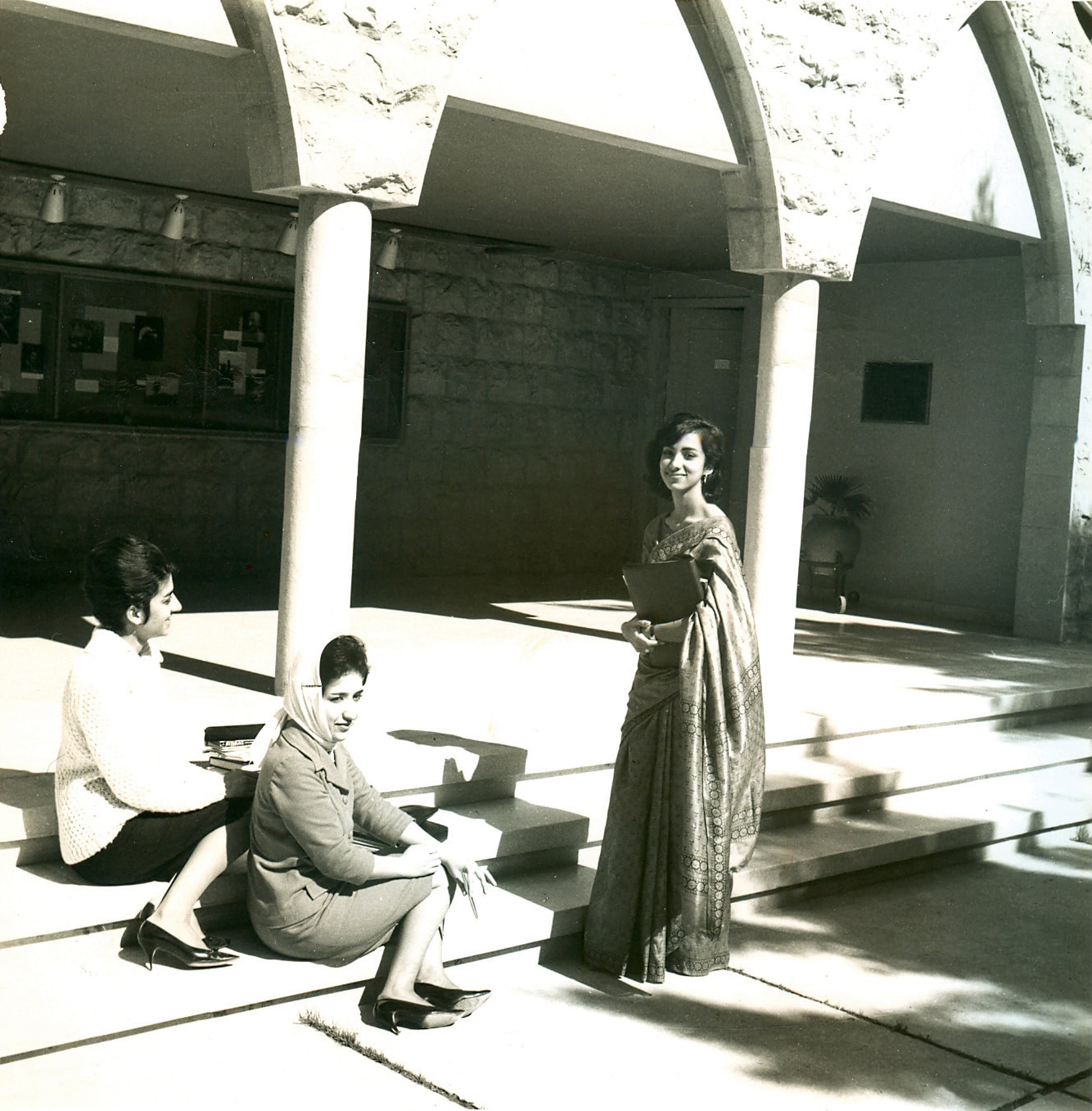
![[Photo]](https://100.lau.edu.lb/images/indian-student-opt.jpg)
As William Stoltzfus becomes AJCW’s president, he extols the diverse backgrounds and nationalities of the student body, as young women from all over the Middle East—Egypt, Iran, Iraq, Palestine and many other countries—joined the college as boarders to acquire a Western-style education in the East. Stoltzfus’ leadership is the start of a long relationship between the university and his family that lives on to this day.
1941
—
1943
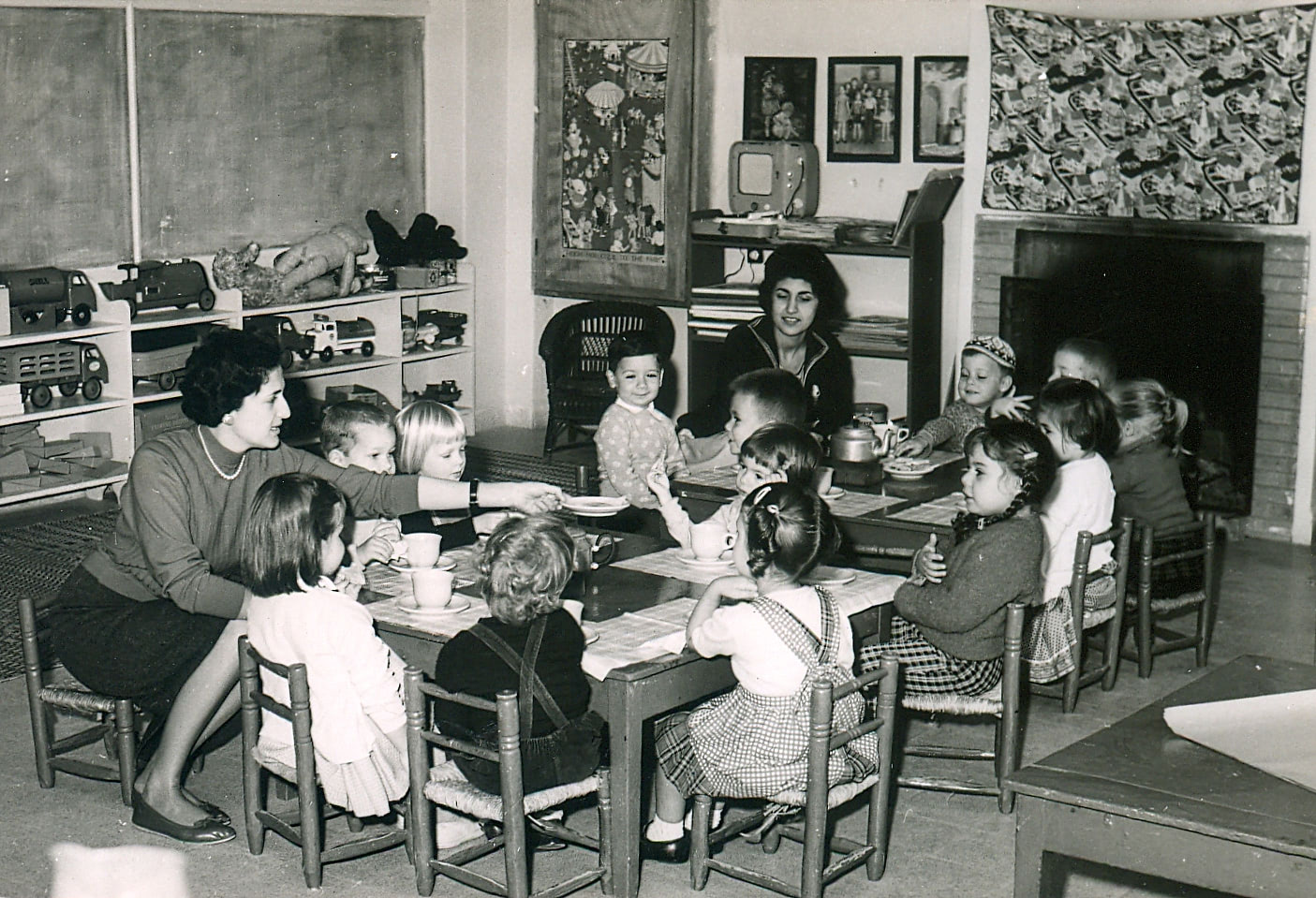
![[Photo]](https://100.lau.edu.lb/images/neighborhood-house-opt.jpg)
James Nicol stands in for President Stoltzfus who is unable to return to Beirut from the US while World War II rages. As the war also makes reaching the villages supported by the Village Welfare Camps precarious, the college launches the Neighborhood House to serve the community in its immediate vicinity.
1948
—
1949
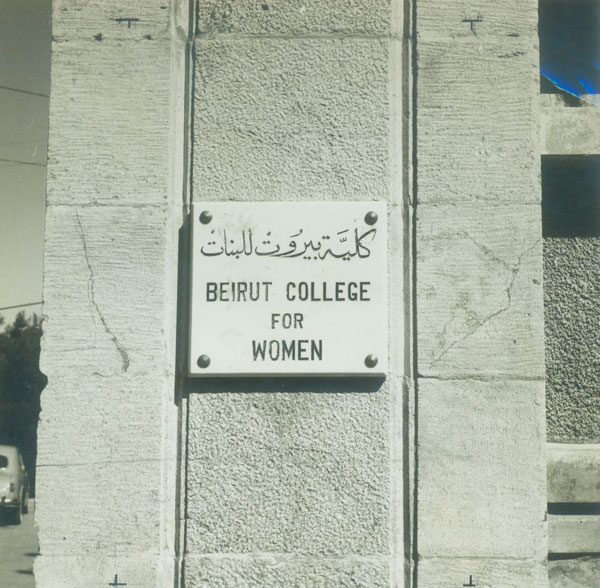
![[Photo]](https://100.lau.edu.lb/images/building-beirut-campus-orme-gray-construction.jpg)
The Syria Mission, under which the institution still operated, authorizes the college to grant BA degrees in Euthenics, Child Development, Education and Psychology, effectively acknowledging its transformation from a two-year junior college to a four-year college under the name of Beirut College for Women (BCW). The transition fulfills President Stoltzfus’ belief that a person’s spiritual capacity is contingent upon achieving one’s intellectual capacity.
1950
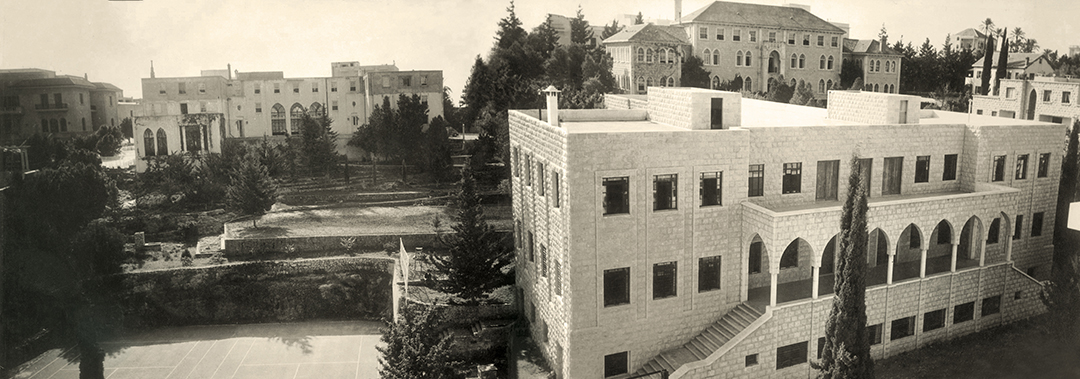
![[Photo]](https://100.lau.edu.lb/images/Campus-AJCW-General-View-1950.jpg)
With the inauguration of Irwin Hall, plays and concerts previously staged in the Sage Hall auditorium change venue. The new theater of professional caliber hosts performances ranging from one-act operettas to classical Greek tragedies, annual Gilbert and Sullivan musicals and shows by the Beirut Orpheus Choir, founded and directed by BCW faculty member and legendary Arab musicologist Afif Alvarez Bulos.
1953
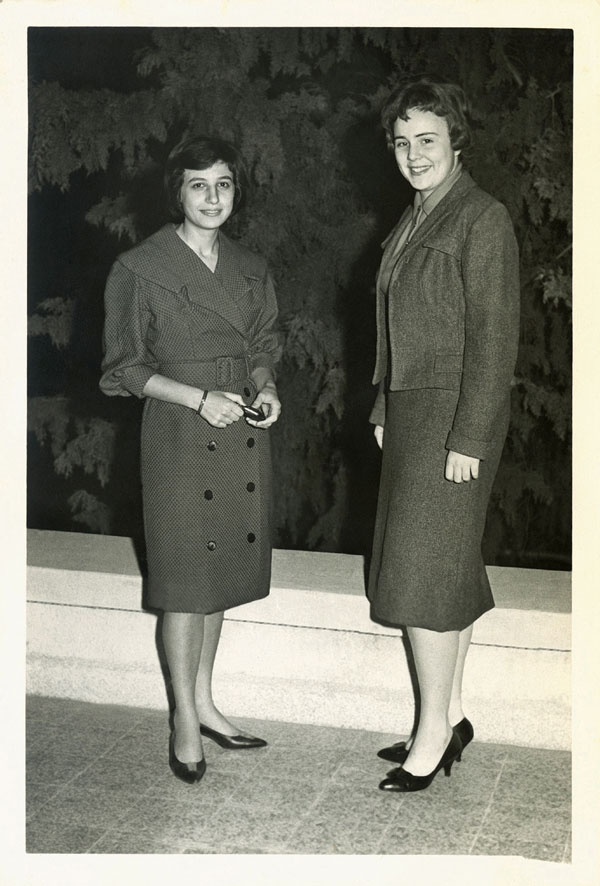
![[Photo]](https://100.lau.edu.lb/images/bcw0207-gail-hovey-and-haya-atour-at-nicol-hall-balcony-1.jpg)
Visionary Presbyterian Margaret Flory founds the Junior Year Abroad program to help forge cross-cultural connections and understanding. She brings several American students to Beirut College for Women in the 1950s and 1960s. For the exchange students, the experience is transformative.
1954
—
1959
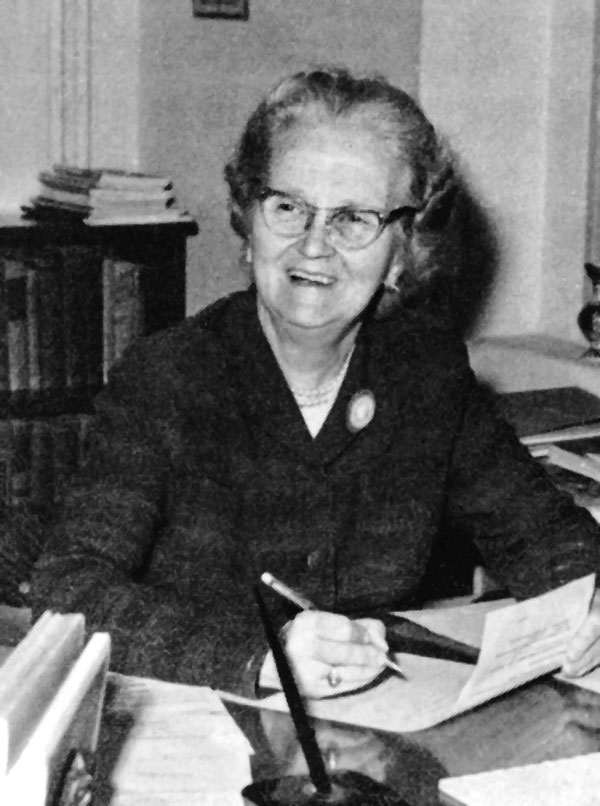
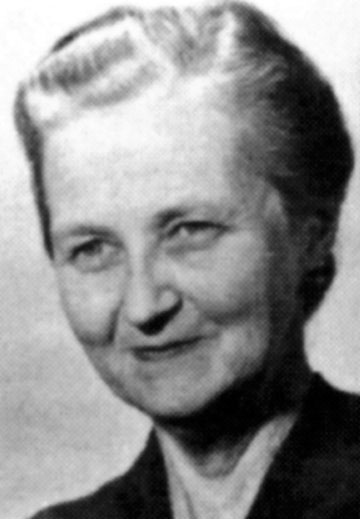
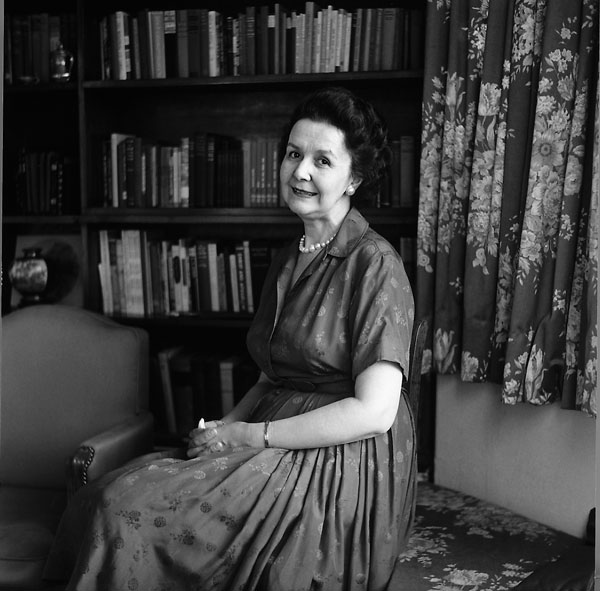
![[Photo]](https://100.lau.edu.lb/images/1954-1959-mobile.png)
Rhoda Orme, who had served for close to 15 years as academic dean, is acting president for a year. She is succeeded by Grace Louks Elliot for a year as well, until the appointment of Frances Gray as College President. In 1965, the building housing the women’s dormitory and the president’s residence is named Orme-Gray in their honor.
1959
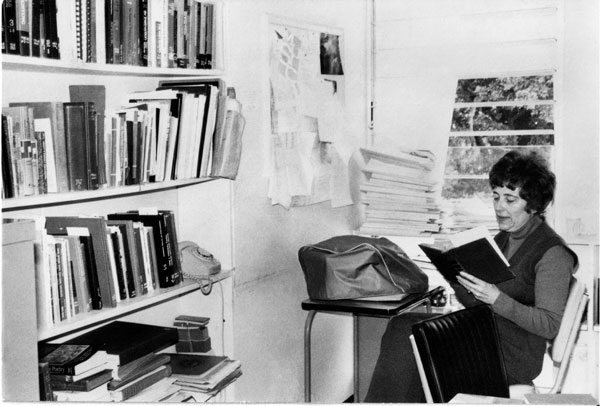
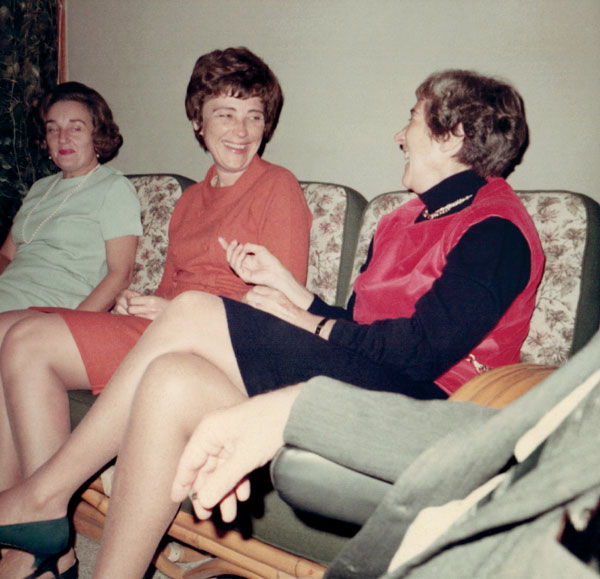
![[Photo]](https://100.lau.edu.lb/images/1959-mobile-irene.png)
Dr. Irene Faffler joins BCW as a professor of literature and drama. After a two-year leave to complete her PhD, she returns to the college in 1965 to serve as chair of the Humanities Division and then in 1982 as academic dean. Dr. Faffler is behind the creation of BCW’s unique Communication Arts department which was designed as a fully interdisciplinary program.
1965
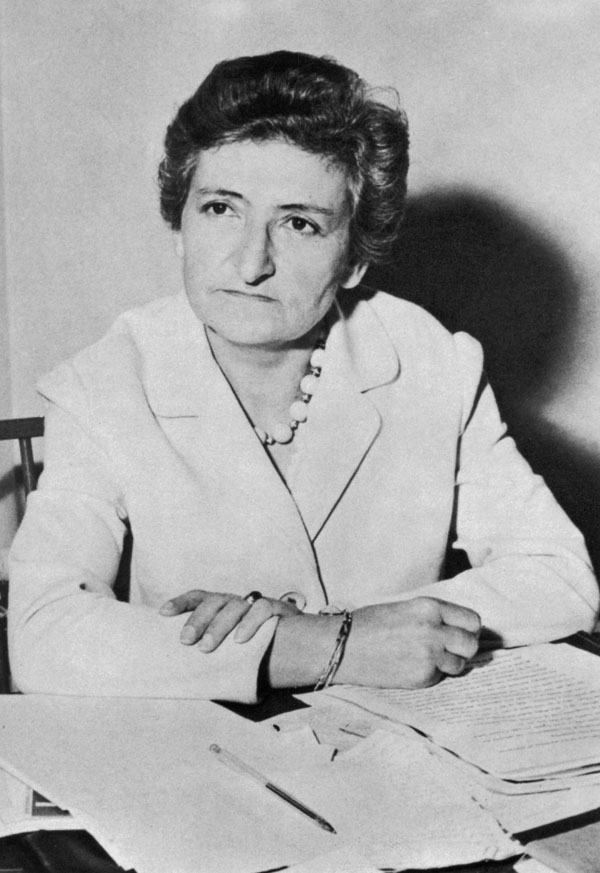
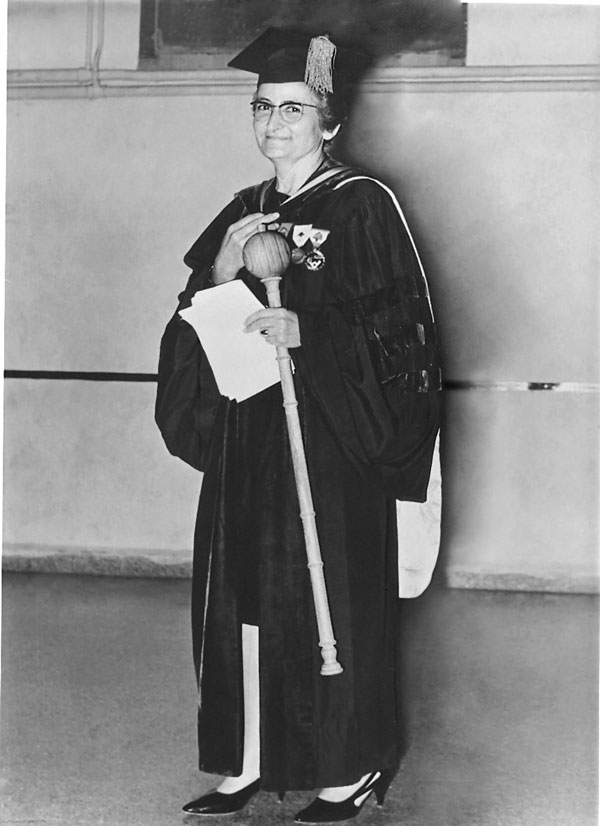
![[Photo]](https://100.lau.edu.lb/images/1965-mobile-salwa.png)
Dr. Salwa Nassar (‘33) takes over the presidency from Frances Gray. Not only is she the first Lebanese woman to head BCW, but she is also the first nuclear physicist in Lebanon. In her inauguration speech, Dr. Nassar outlines her vision for establishing a program in Lebanese Studies and empowering women to serve their community through Continuing Education. Previously, as chair of the Science Department in 1956, Dr. Nassar introduced physics and enhanced the physics, chemistry and mathematics curricula, and as once president of the Alumnae Association she added an alumnae seat to the Board of Management of the College.
1967
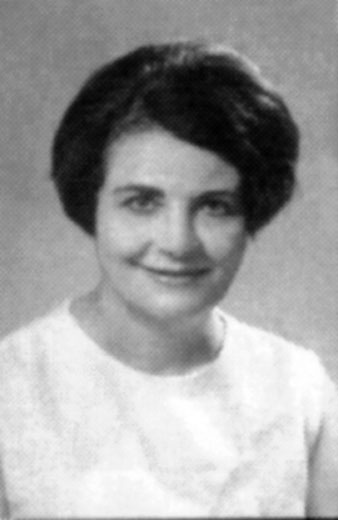
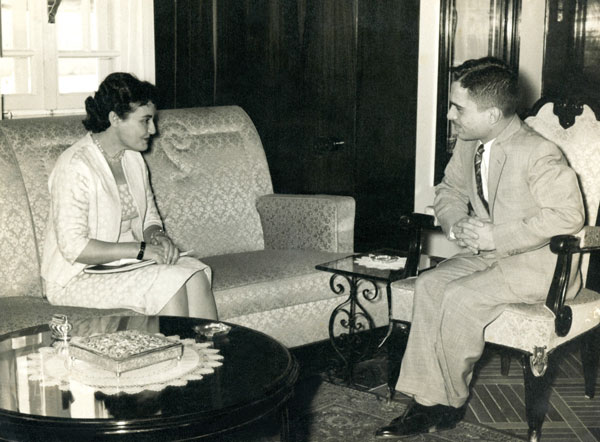
![[Photo]](https://100.lau.edu.lb/images/1967-mobile-marie.png)
Dr. Marie Sabri is appointed acting president following Dr. Nassar’s passing and at a critical time in the region. Because of her close rapport with students, she manages to contain their anger after the defeat of the Arab forces in the 1967 Six-Day War. Despite the tensions brought about the war and its aftermath, she travels in the Arab world and abroad to promote and secure financial support for the college.
1969
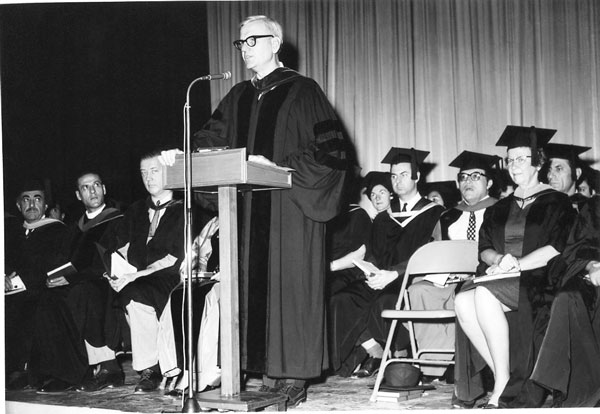
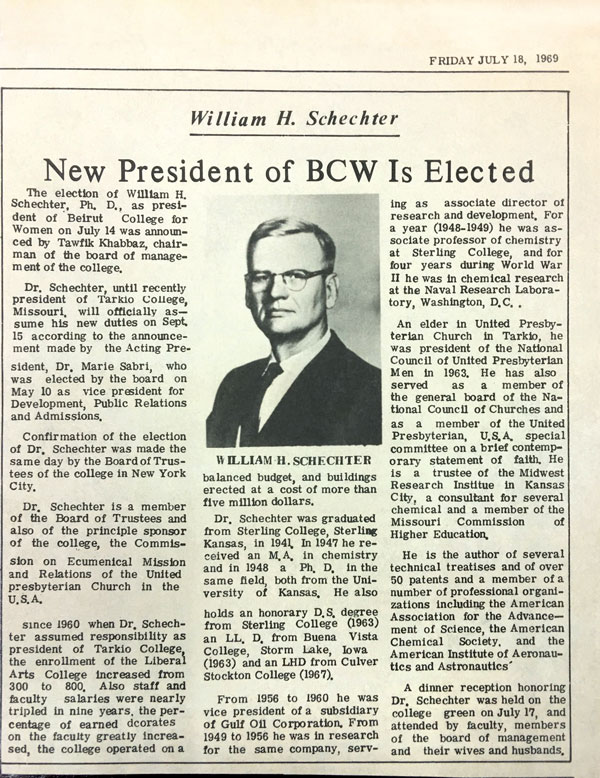
![[Photo]](https://100.lau.edu.lb/images/1969-mobile-william.png)
Dr. William H. Schechter is appointed as president of the college. He establishes a participatory governance system that includes faculty, staff and students, and an Executive Council, a governing body reflecting all college stakeholders. He also lays the groundwork for admitting male students, to have men and women collaborate as intellectual equals for the good of the society they are building.
1973
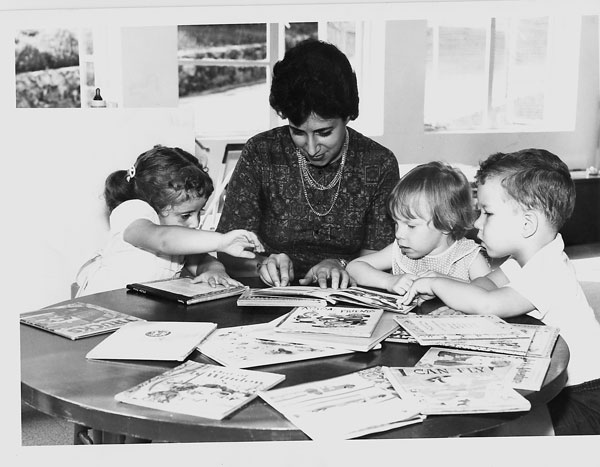
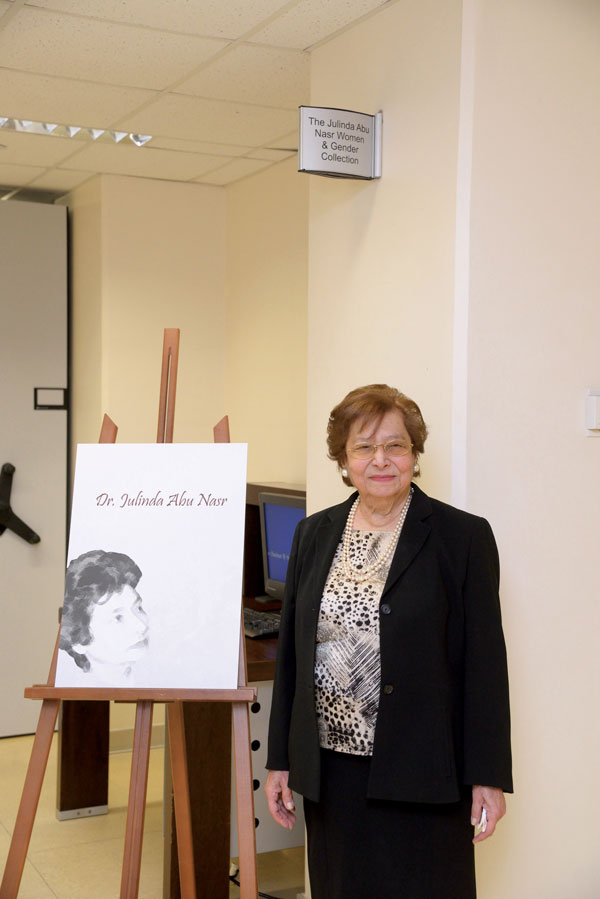
![[Photo]](https://100.lau.edu.lb/images/1973-mobile-shechter.png)
Dr. Shechter appoints Dr. Julinda Abu Nasr (‘53) as founding director of the Institute of Women’s Studies in the Arab World on her return from the US where she completed a PhD in Developmental Psychology at Florida State University. Dr. Abu Nasr continues to head the institute and steer its growth up to 1997.
1973
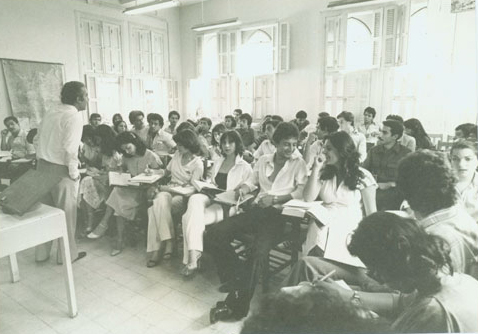

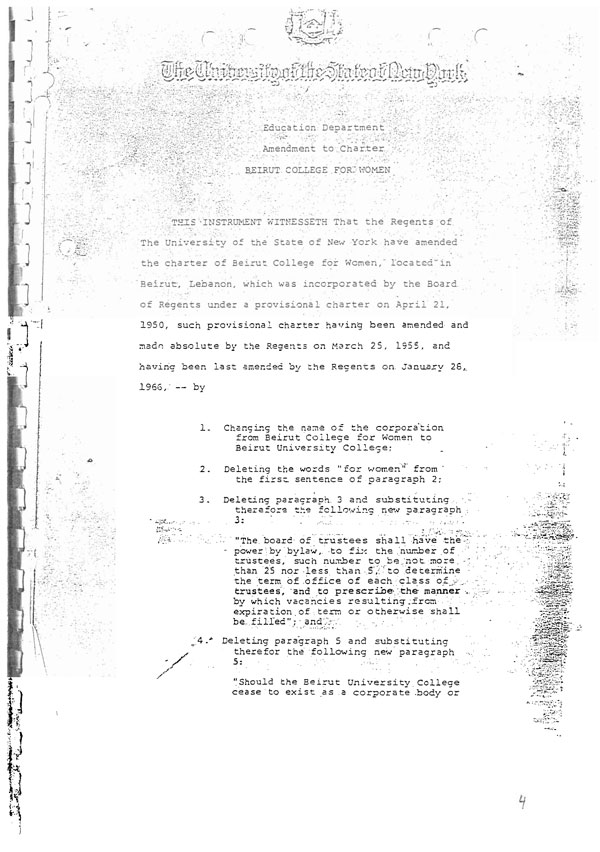
![[Photo]](https://100.lau.edu.lb/images/1973-mobile-outgoing.png)
Outgoing President Schechter announces that the college would become a Church-related, not Church-controlled institution “as a necessary step” in its “growth and development as an institution.” The Board of Trustees votes to admit male students, transforming the historically women’s institution into a fully coeducational one starting in October 1973. To formalize the decision, BCW is renamed Beirut University College that same academic year.
1973
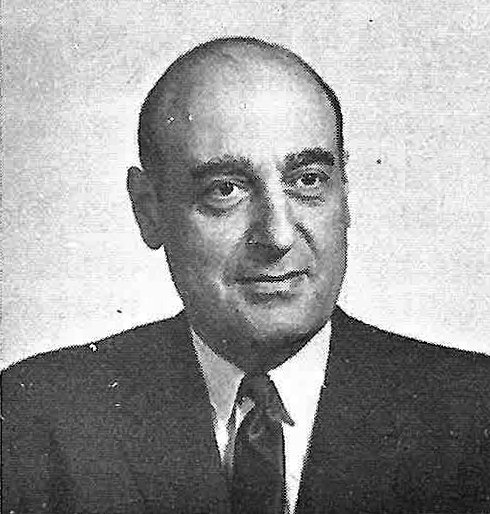
![[Photo]](https://100.lau.edu.lb/images/albert-badre.jpg)
Dr. Albert Y. Badre succeeds President Schechter. Two years into his tenure, he is faced with the challenge of safeguarding the university during a protracted civil war.
1974
—
1981
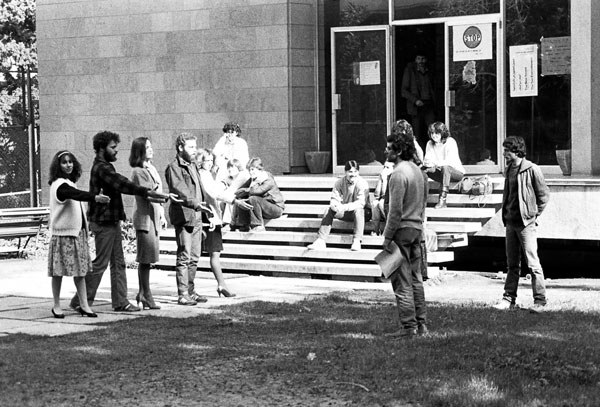
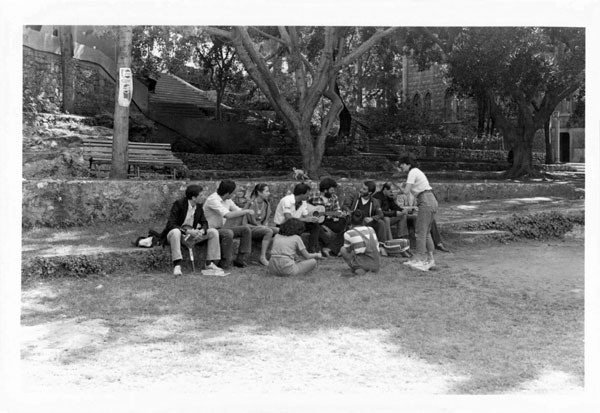
![[Photo]](https://100.lau.edu.lb/images/1974-1981-mobile-fall.png)
Fall of 1975 was to President Badre the university’s “darkest hour.” Street battles, shelling, and faculty and staff kidnappings are the everyday reality of the Lebanese civil war. Yet, faculty and staff pull together and keep campus gates open, reverse enrollment numbers, and seek external sources of financial aid. Perhaps the most telling resilient sentiment on campus was that of the communication arts faculty, staff and students, who, adamant that the show must go on, continued to stage plays.
1982
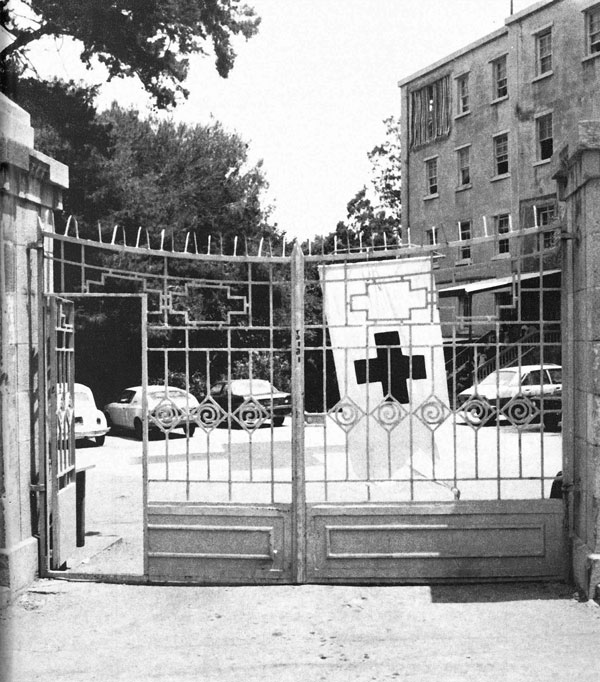
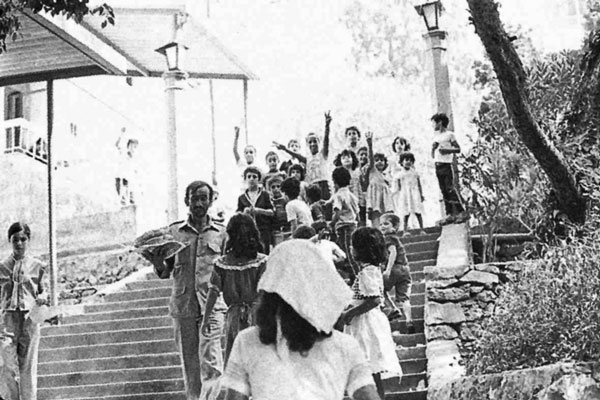
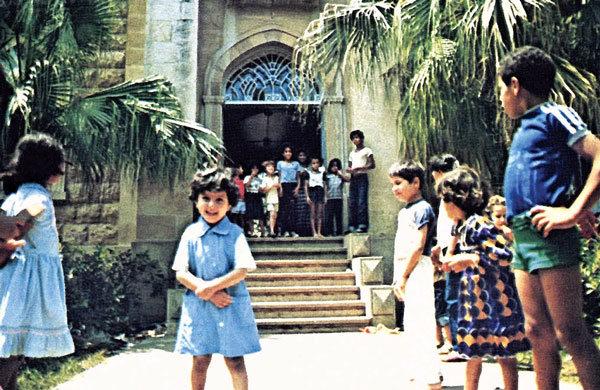
![[Photo]](https://100.lau.edu.lb/images/1982-entry-1-mobile.png)
Following the Israeli invasion of Beirut, summer classes are suspended for the first time ever. BUC opens its gates to refugees from neighboring areas and the south. Around 700 people, mostly children, shelter in Sage and Nicol halls, cared for by the students who form a general relief committee that coordinates with various relief agencies.
1982
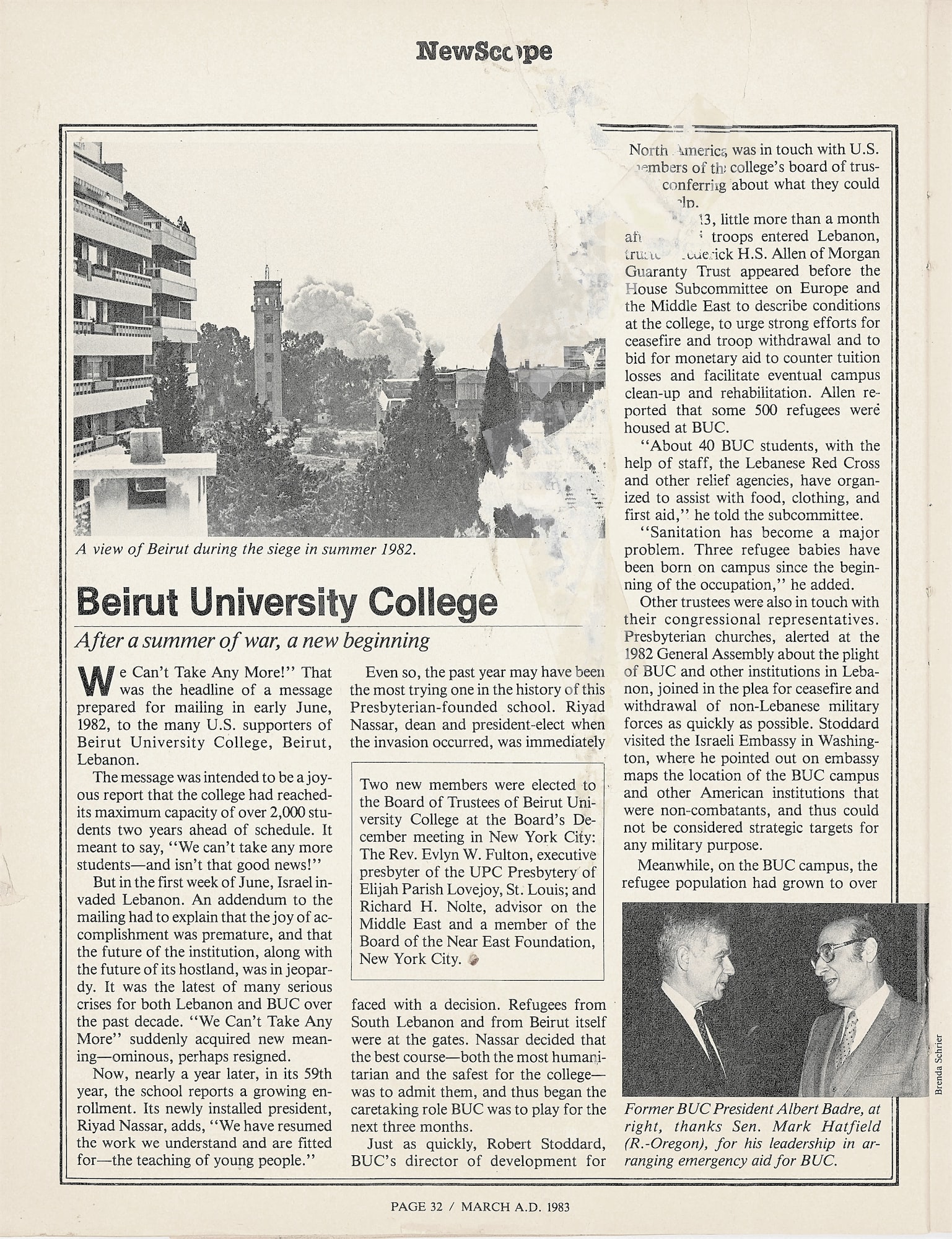
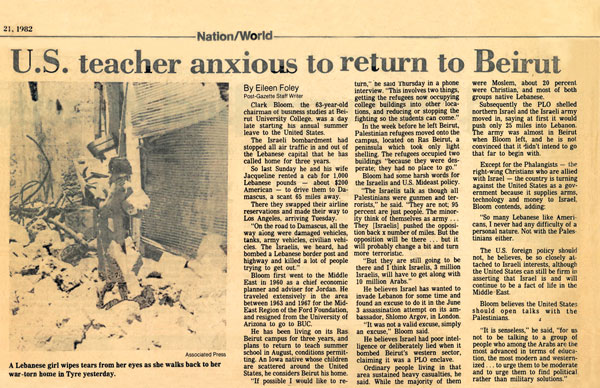
![[Photo]](https://100.lau.edu.lb/images/1982-entry-2-mobile.png)
In the summer of 1982, Dr. Badre and Bob Stoddard, BUC director of development for North America, lead a successful emergency campaign to keep the institution running and repair war damages. American faculty who had left Lebanon are called back for the college’s planned reopening in October 1983, and student enrollment reaches 1,835. The US Congress passes a bill recommending substantial emergency assistance for BUC.
Oct.
—
1982
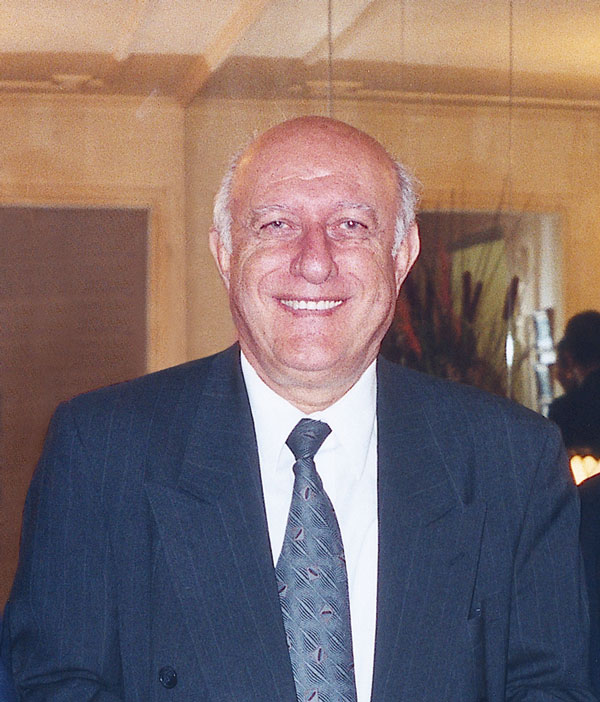
![[Photo]](https://100.lau.edu.lb/images/nassar-riyad.jpg)
Dr. Riyad F. Nassar begins his 22-year tenure as the seventh president of BUC.
1982
—
1986
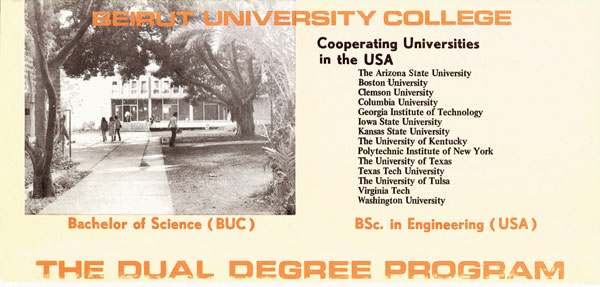
![[Photo]](https://100.lau.edu.lb/images/brochure-buc-bs-engineering-the-dual-degree-program-1.jpg)
Notwithstanding the difficult circumstances, a pioneering Dual Degree program is launched: Undergraduates who had completed three years at BUC could continue their studies for two additional years at a partner university in the United States and receive BS degrees from both institutions. The program leads to the establishment of the Department of Engineering.
1985

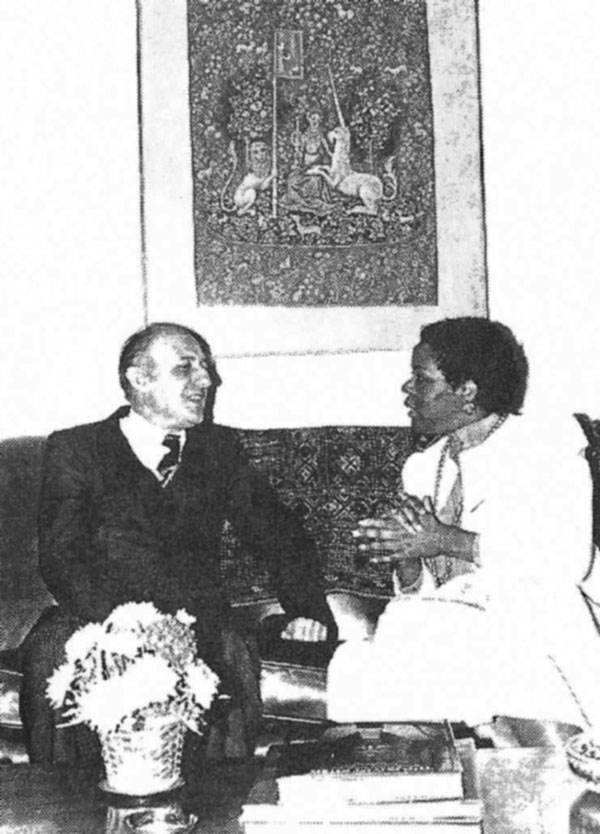
![[Photo]](https://100.lau.edu.lb/images/1985-mobile-devaluation.png)
As the devaluation of the Lebanese pound threatens faculty retention, Dr. Nassar embarks on an aggressive fundraising campaign, raising money for the first successful endowment fund.
1987

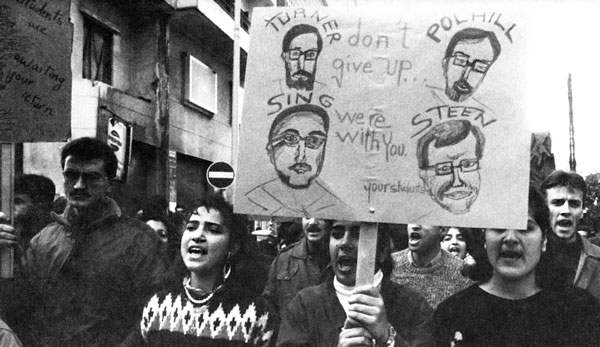
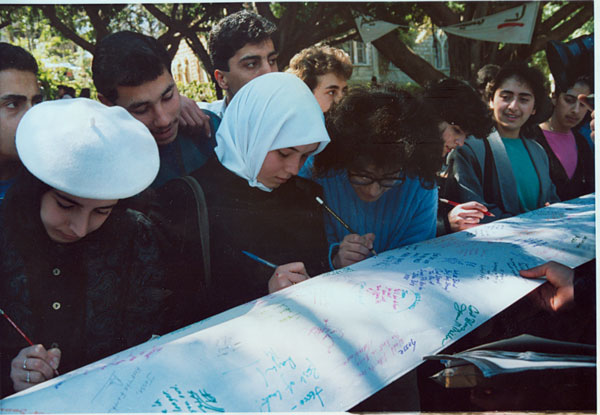
![[Photo]](https://100.lau.edu.lb/images/1987-mobile.png)
Faculty members Mishelishwar Singh, Robert Polhill, Alan Steen and Jessie Turner are kidnapped. The BUC community mobilizes through protests and petitions for their release.
1987
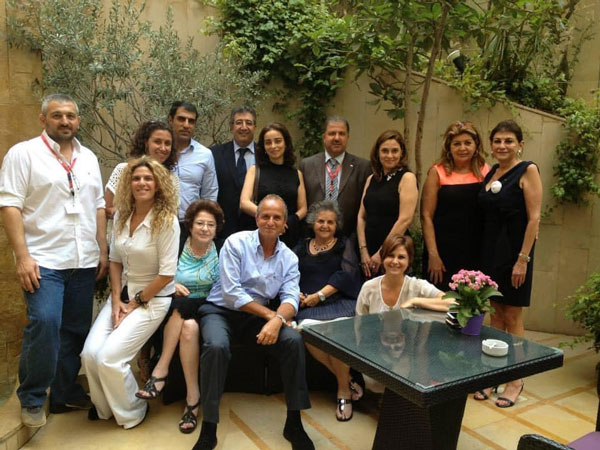

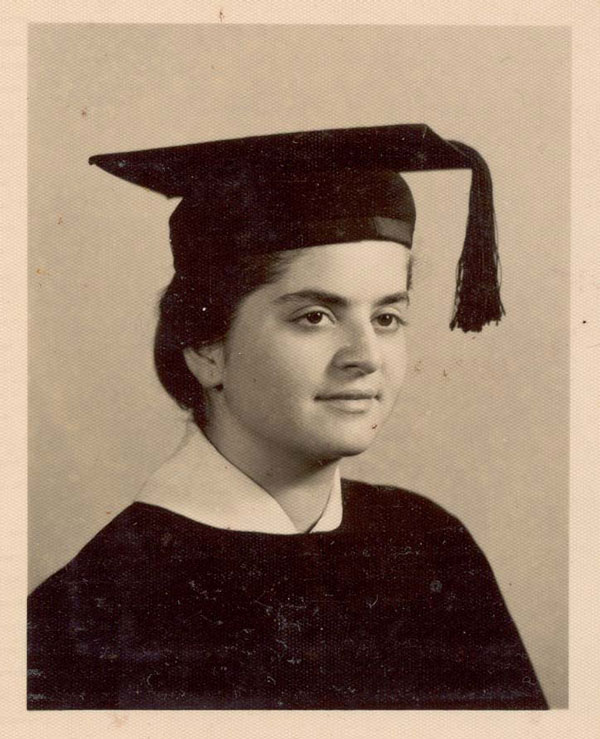
![[Photo]](https://100.lau.edu.lb/images/1987-2-mobile.png)
Leila Al Saleeby Dagher (BA ’60) is appointed director of Alumni Relations and later of the admissions and registrar’s offices. Her service to the institution would span six decades during which she revives and sets up alumni chapters and lays the groundwork for some of the most vital offices at present-day LAU.
1988
—
1991
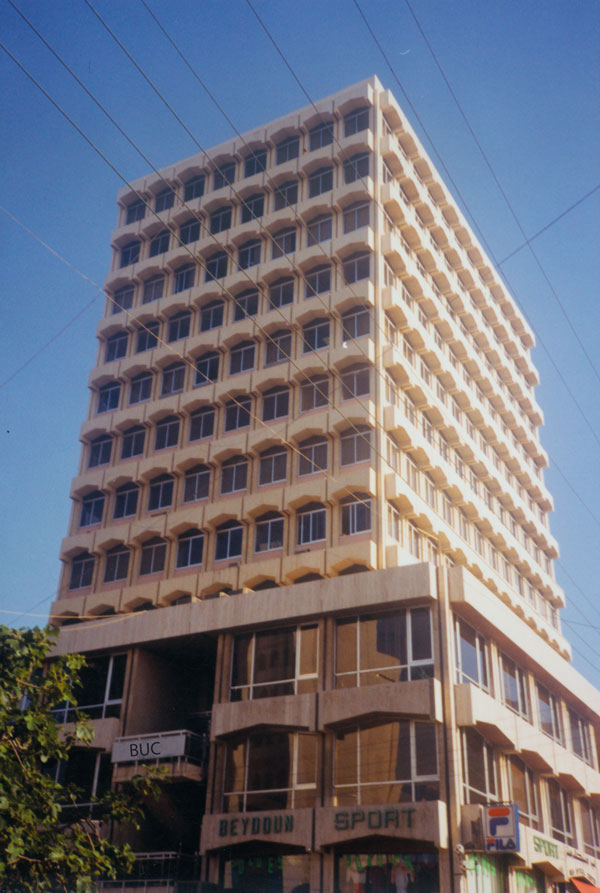
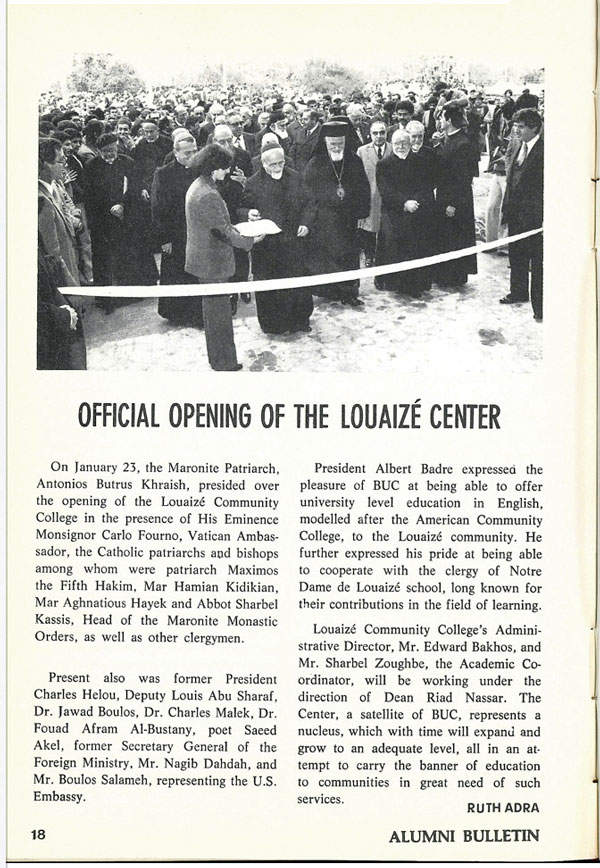
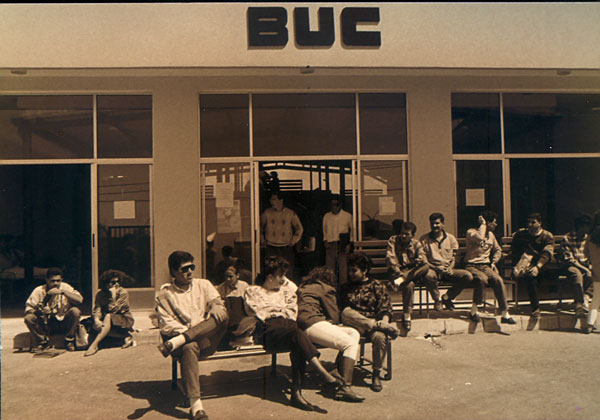
![[Photo]](https://100.lau.edu.lb/images/1988-1991-mobile.png)
The war rages on and access to Beirut campus from the eastern side of town becomes a growing challenge to students, faculty and staff. The president himself has no choice but to relocate from his residence in Orme-Gray to his hometown of Munsif. Three consecutive temporary branches in Louaizeh, Amchit, and Sidon are set up to cater to students unable to reach Beirut. The new Byblos campus opens in the fall of 1991.
1992
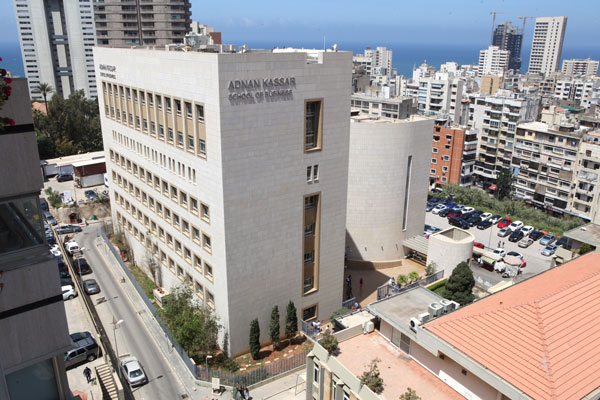
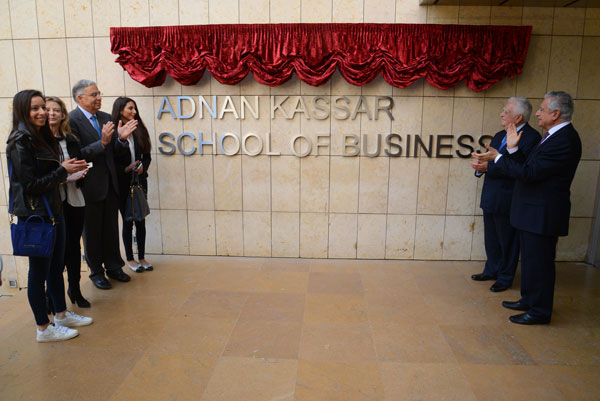
![[Photo]](https://100.lau.edu.lb/images/1992-mobile.png)
The school of business is founded in Beirut under the leadership of Dr. Tarik Mikdashi, and in 1995, is headed on the Byblos campus by Dr. Wassim Shahin. It would be named in 2015 in honor of generous donor Adnan Kassar.
1993
—
1994
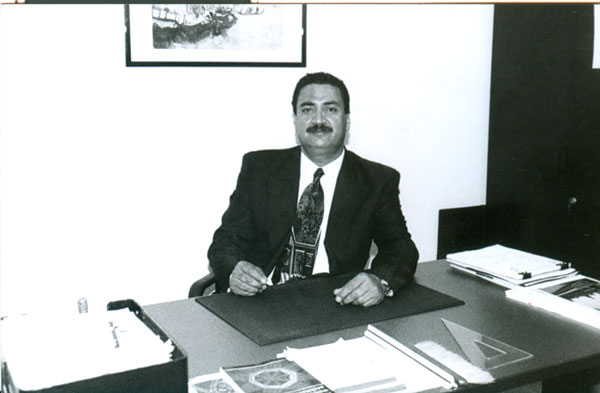
![[Photo]](https://100.lau.edu.lb/images/mr-rachid-chamoun-chairman.jpg)
The Board of Trustees approves the founding of the School of Architecture and Engineering and the School of Pharmacy. The first class of architecture is held by Dr. Rachid Chamoun, who was recruited from the US, to teach the program, to 30 students in the Amchit rented buildings as the Byblos Campus is still under development.
1994
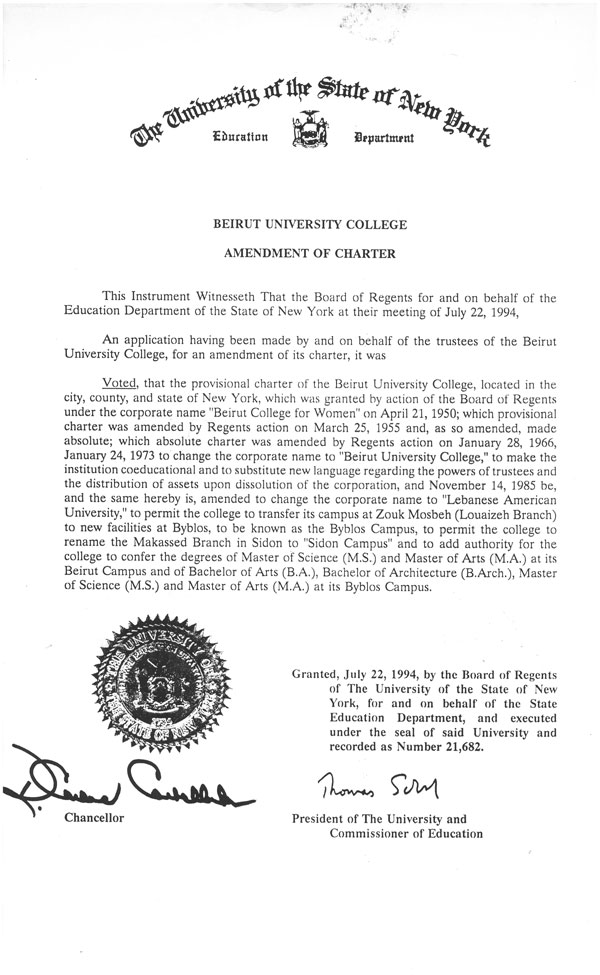
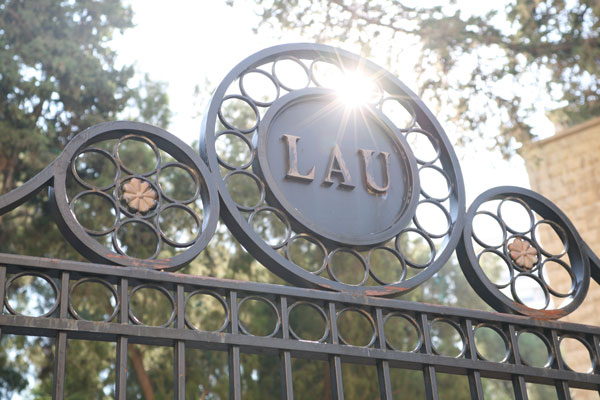
![[Photo]](https://100.lau.edu.lb/images/1994-mobile-buc.png)
On BUC’s 70th anniversary, with four established schools, the Board of Trustees petitions the Board of Regents of the State of New York to change the institution’s status from a college to a university named Lebanese American University.
1995
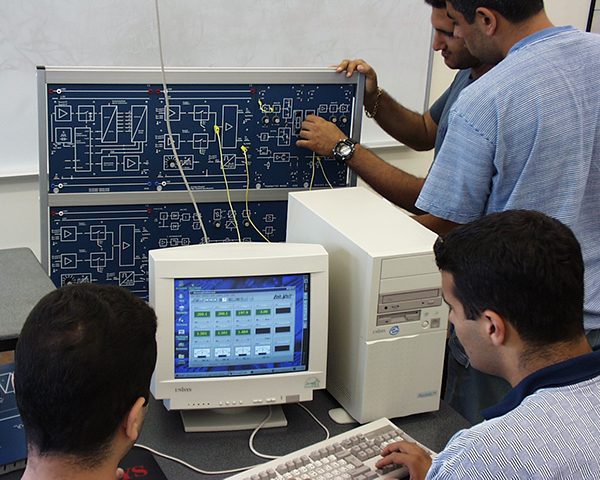
![[Photo]](https://100.lau.edu.lb/images/abdallah-sfeir-2-2012.jpg)
Under the deanship of Dr. Abdallah Sfeir, the bachelor’s degree in engineering is launched with three majors: civil, electrical and computer followed by mechanical three years later.
2002
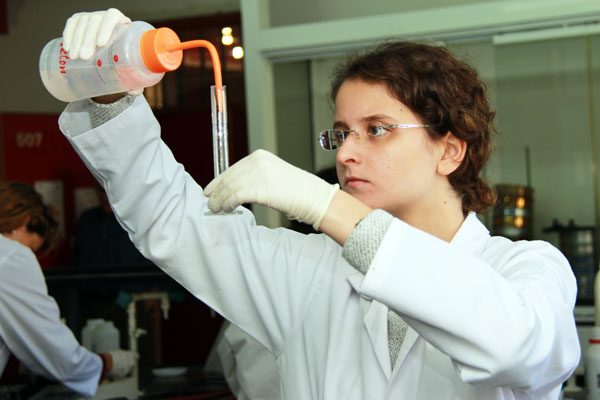
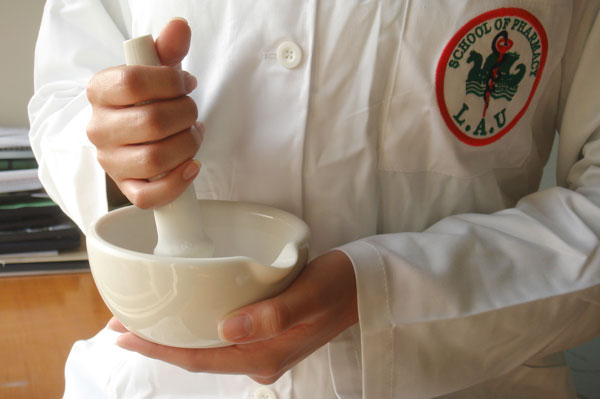
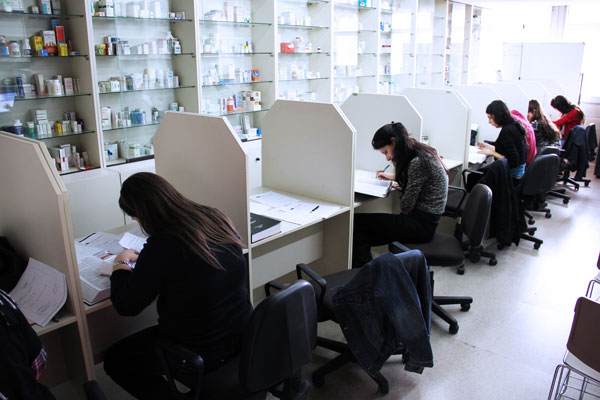
![[Photo]](https://100.lau.edu.lb/images/2002-the-doctor-mobile.png)
The Doctor of Pharmacy program becomes the only one outside the United States to earn accreditation by the Accreditation Council for Pharmacy Education.
2004
—
2005
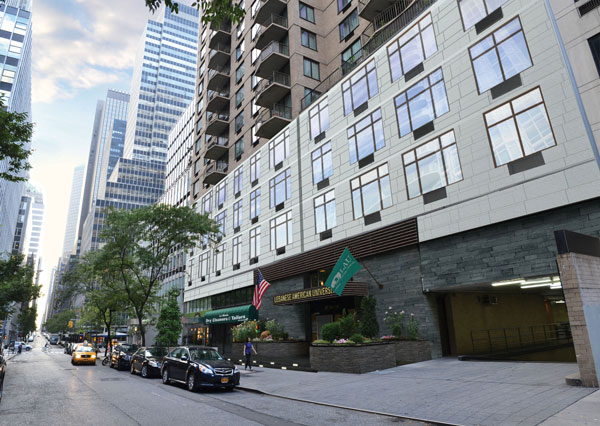
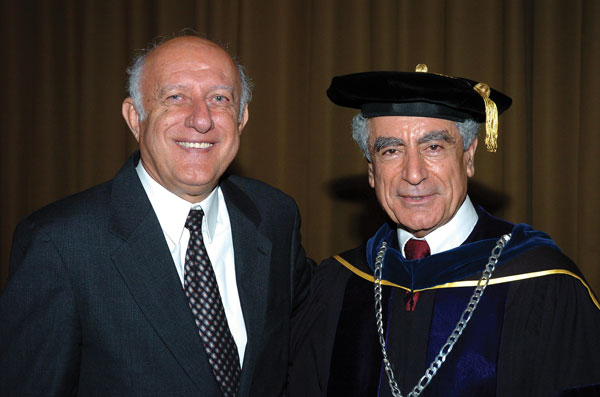
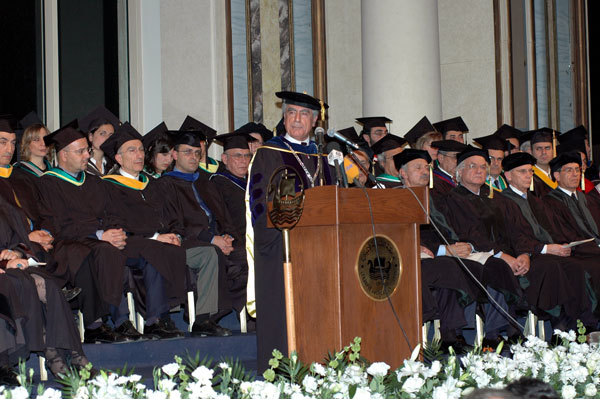
![[Photo]](https://100.lau.edu.lb/images/2004-2005-mobile.png)
Dr. Joseph G. Jabbra takes over the reins from President Nassar in times of turmoil and a wave of assassinations in the country, most notably that of Prime Minister Rafic Hariri the following year.
Dr. Jabbra institutes a five-year strategic plan with the primary goal of securing accreditation for the university, establishing a medical school, a nursing school, a medical center, a school of architecture and design, and a headquarters and academic center in New York.
2006
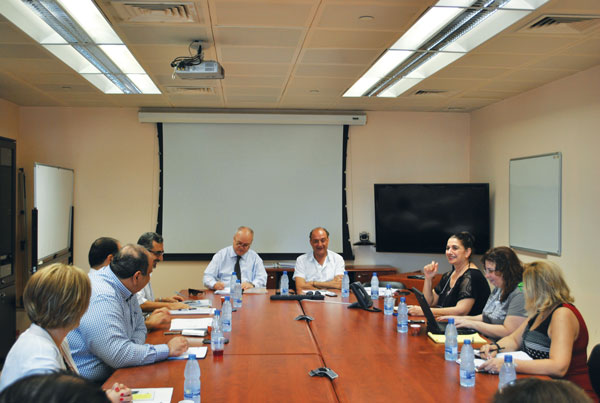
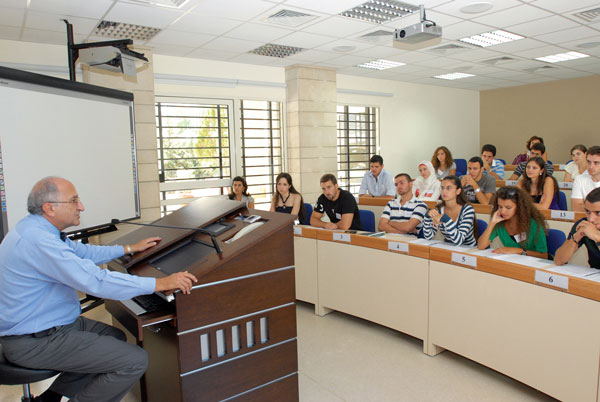
![[Photo]](https://100.lau.edu.lb/images/2006-mobile.png)
Amid wartime conditions, with the outbreak of the July 2006 war in Lebanon, Dr. Jabbra secures the approval of the New England Association of Schools and Colleges* to expedite the university’s accreditation process. Dr. Kamal Badr is appointed by the Board of Trustees as founding dean of the medical school.
* Presently the New England Commision of Higher Education
2007
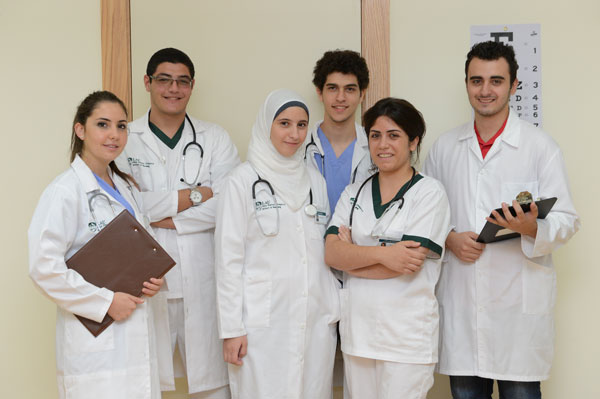
![[Photo]](https://100.lau.edu.lb/images/pro-063-first-class-2010.jpg)
The Alice Ramez Chagoury School of Nursing is established with the purpose of educating professional nurses who use their “head, heart and hands,” according to founding Dean Nancy Hoffart. The school admits its first students three years later, in 2010.
2008
—
2013
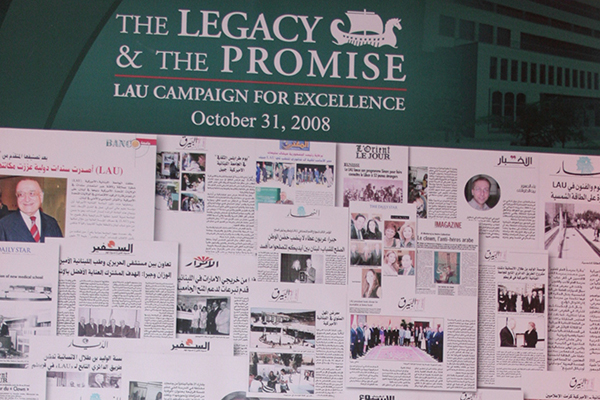
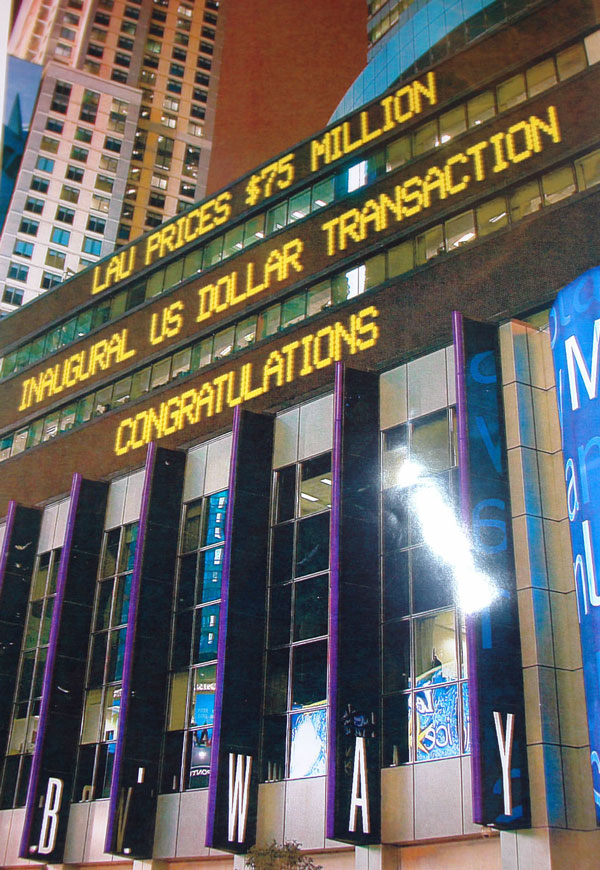
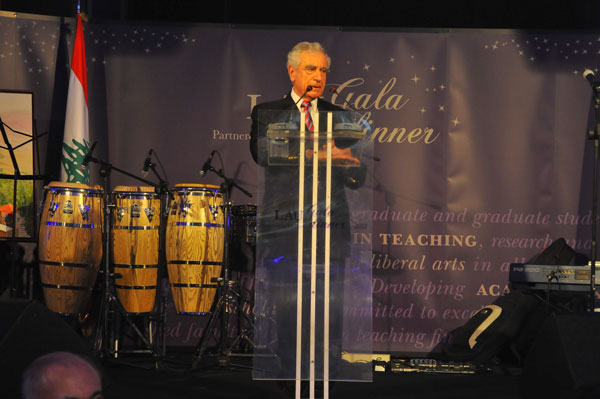
![[Photo]](https://100.lau.edu.lb/images/2008-2013.png)
As part of the university’s strategic plans, consecutive fundraising campaigns, The Legacy and the Promise (2008) and Fulfilling the Promise (2013), serve to secure the university’s survival.
2009
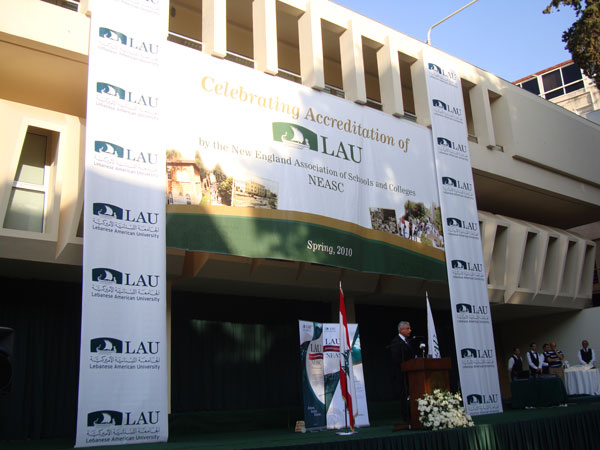
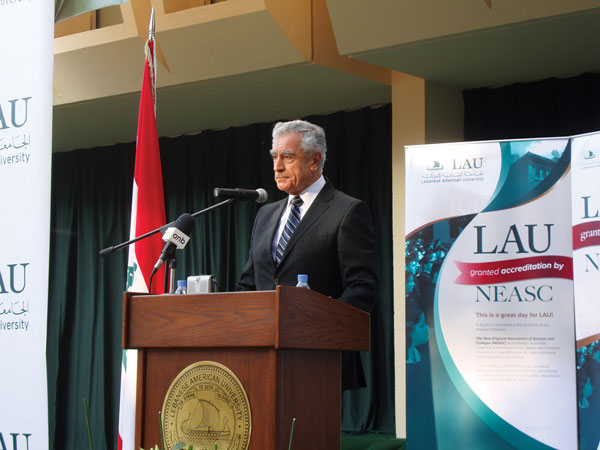
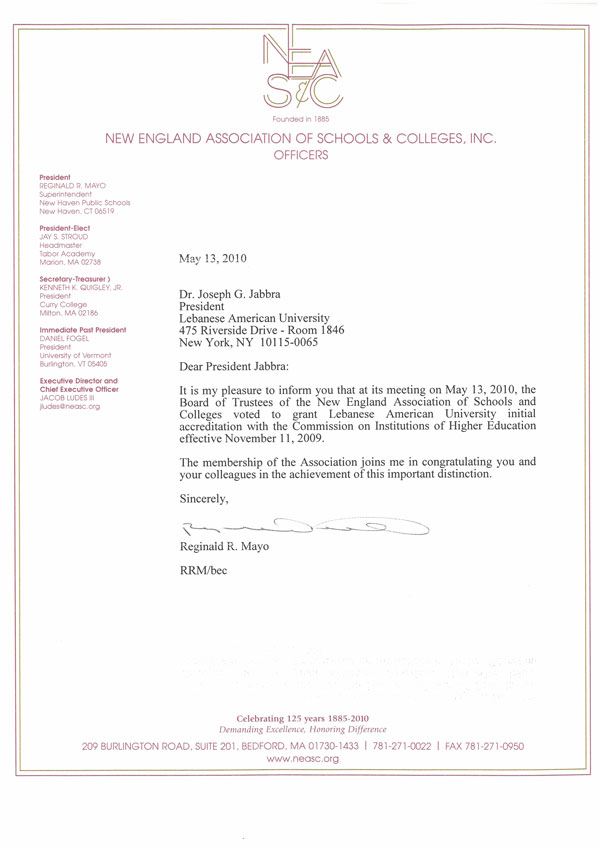
![[Photo]](https://100.lau.edu.lb/images/2009-mobile-lau.png)
LAU is granted full accreditation. A series of additional program accreditations ensues over the following 14 years, in engineering, computer science, business, hospitality and tourism management, design, architecture, nutrition and dietetics, nursing, and medicine.
2009
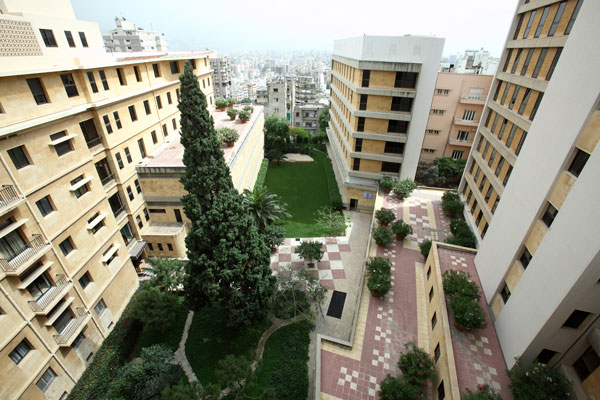
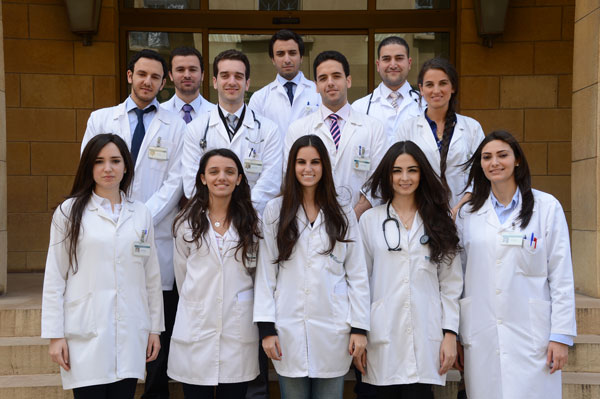
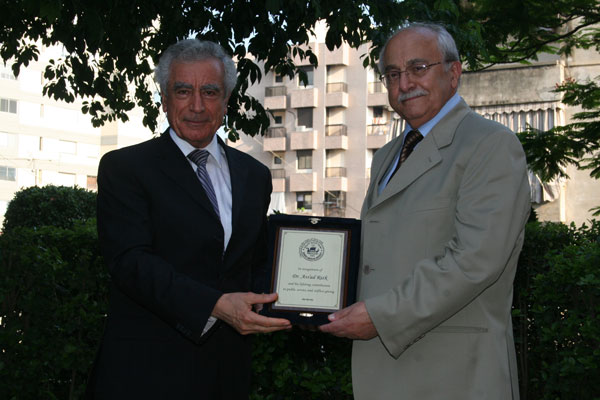
![[Photo]](https://100.lau.edu.lb/images/2009-mobile.png)
The Gilbert and Rose-Marie Chagoury School of Medicine welcomes its first cohort of students. In that same year, the university acquires Rizk Hospital and renames it the LAU Medical Center–Rizk Hospital, supplementing the existing staff with top-notch physicians from the US and Europe.
2013
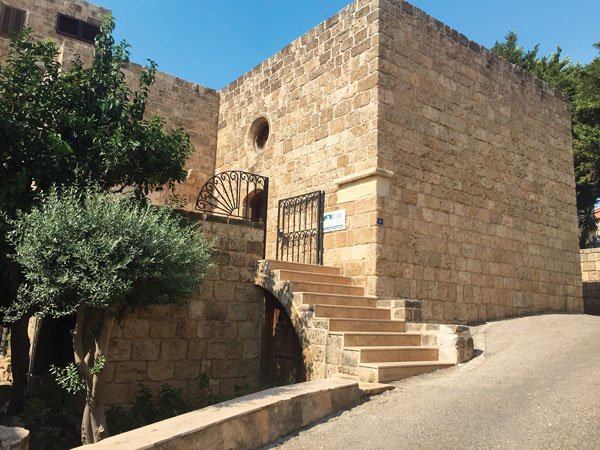
![[Photo]](https://100.lau.edu.lb/images/building-byblos-cardahi-museum-outside-with-plaque-2016.jpg)
The Byblos-based Cardahi family bequeaths the Louis Cardahi Foundation it established in 1985 to LAU to help cultivate in Lebanese youth an appreciation of their rich heritage. In that same year, LAU’s New York Headquarters and Academic Center is inaugurated in midtown Manhattan.
2014
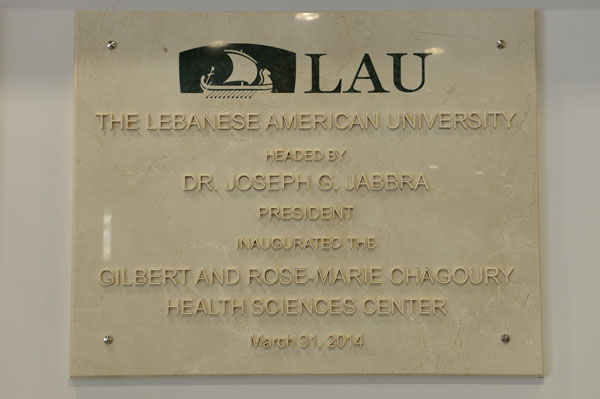
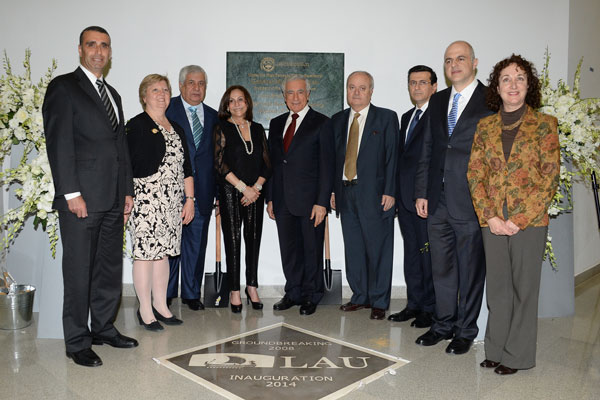
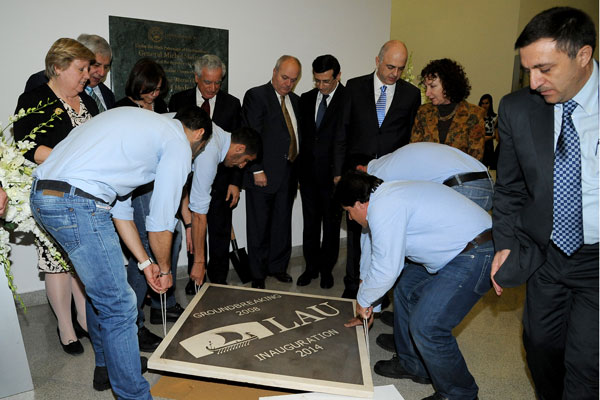
![[Photo]](https://100.lau.edu.lb/images/2014-mobile.png)
The Gilbert and Rose-Marie Chagoury Health Sciences Center, housing the schools of medicine, nursing and pharmacy, is inaugurated and becomes a hub for interprofessional education which includes the departments of nutrition and social work. Social medicine distinguishes LAU’s medical, nursing and pharmacy programs.
2017
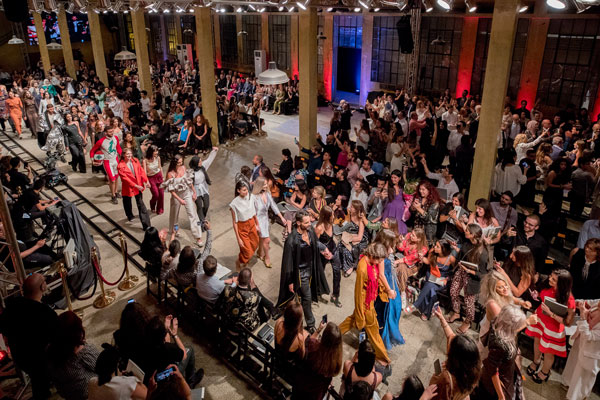
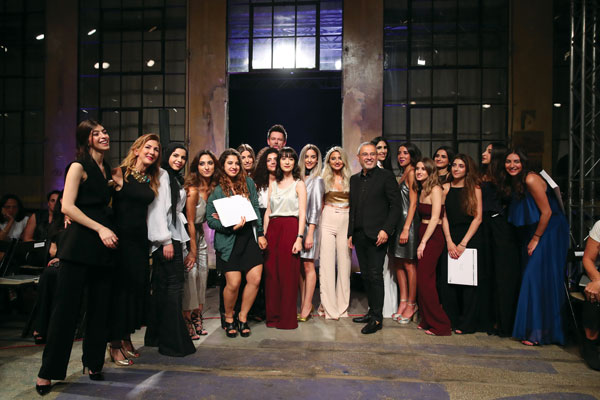
![[Photo]](https://100.lau.edu.lb/images/2017-mobile.png)
The first class of the fashion design program graduates. The school holds an eclectic runway featuring 160 outfits, created by the students and overseen by the program’s honorary chairman Elie Saab. The program is the first-of-a-kind in the region, and excelling students are rewarded with invaluable internship opportunities at ELIE SAAB every year.
2019
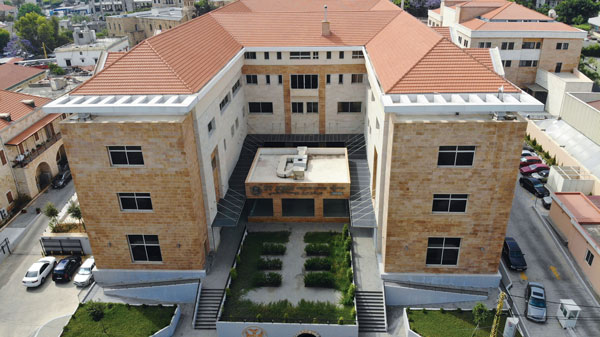


![[Photo]](https://100.lau.edu.lb/images/2019-mobile.png)
The Fouad Makhzoumi Innovation Center is established as a hub for incubating and accelerating new ideas and providing seed funding for entrepreneurial projects by the youth. That same year sees the opening of the new Joseph G. Jabbra Library on the Byblos campus, and the acquisition of Saint John’s Hospital in Jounieh.
2019

![[Photo]](https://100.lau.edu.lb/images/emergency-fund-2019.jpg)
The October Revolution, economic meltdown and the COVID-19 pandemic place a huge financial burden on students and their parents. In response, the university introduces a set of austerity measures and launches the Emergency Financial Aid Fund to ensure that no student is forced to forgo an education.
2020
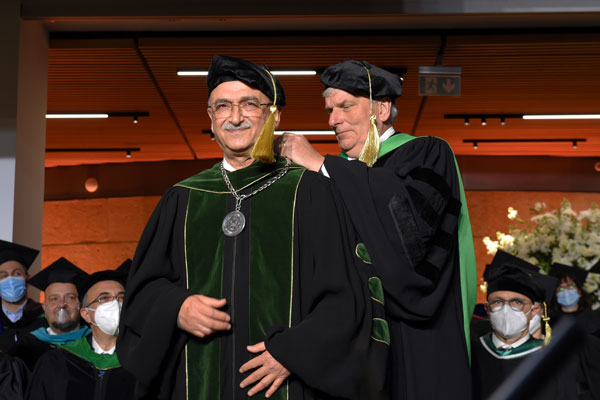
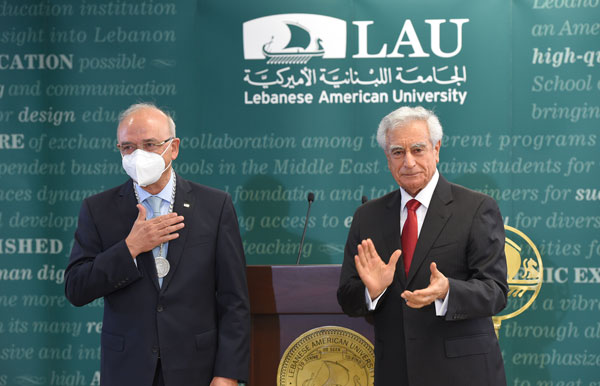
![[Photo]](https://100.lau.edu.lb/images/2020-on-dr-jabbra.png)
On Dr. Jabbra’s retirement, the Dean of the Gilbert and Rose-Marie Chagoury School of Medicine, Dr. Michel E. Mawad, is appointed as LAU’s ninth president. He assumes the role at the height of the COVID-19 pandemic and Lebanon’s worst economic and financial crises.
2020
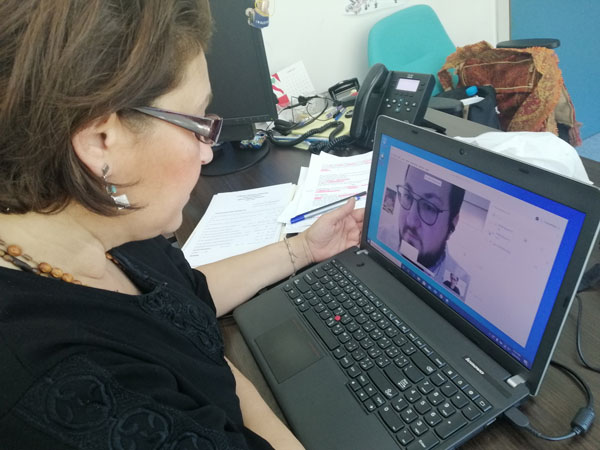
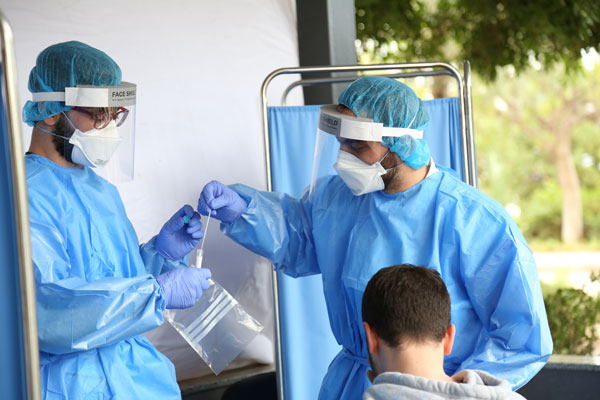
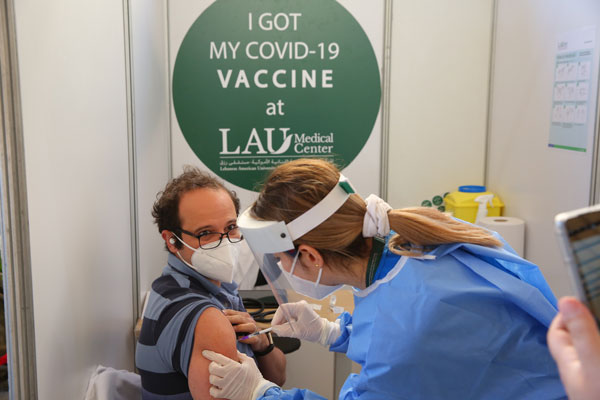
![[Photo]](https://100.lau.edu.lb/images/2020-mobile.png)
Teaching and university operations are not hindered by the lockdown as faculty, staff and students make the swift shift to online learning and communication. If anything, the university and its medical center go above and beyond to sustain their service to the immediate and broader community with initiatives such as the LAU Mobile Clinic that administers PCR tests and vaccinations free of charge across Lebanon.
Aug. 4
—
2020
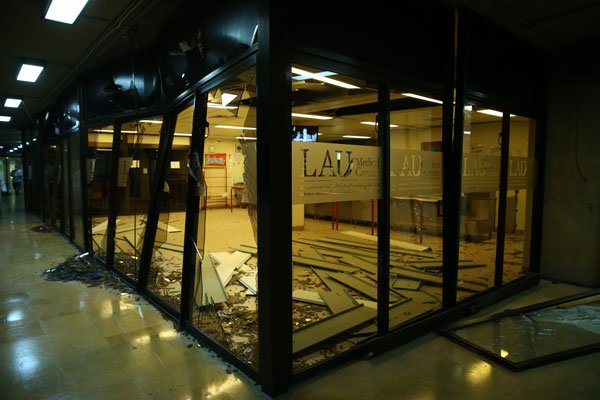
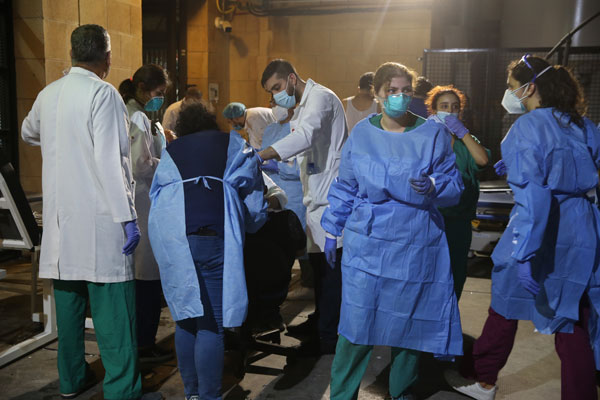
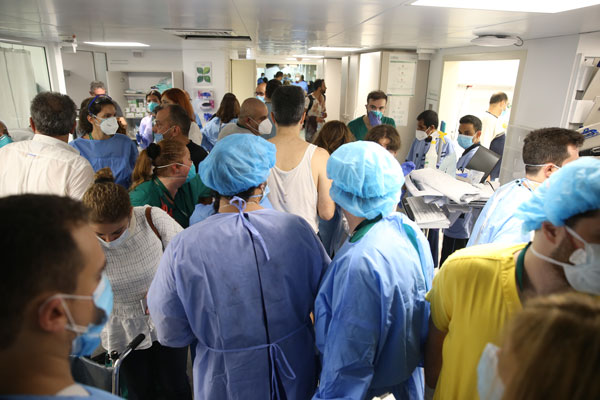
![[Photo]](https://100.lau.edu.lb/images/aug4-2020-mobile.png)
Located within three kilometers of the Port of Beirut, the LAU Medical Center–Rizk Hospital sustains physical damage, but as it remains operational, it is overrun with casualties from the explosion. Attending and off-duty physicians, nurses, residents and staff mobilize to treat more than 350 patients.
Sept.
—
2020
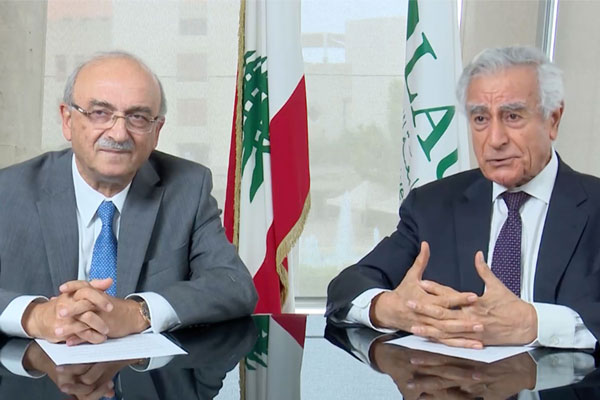
![[Photo]](https://100.lau.edu.lb/images/presidents-2020.jpg)
In the aftermath of the explosion, Dr. Jabbra and then president-elect, Dr. Michel Mawad, make a joint appeal for student financial aid.
2021
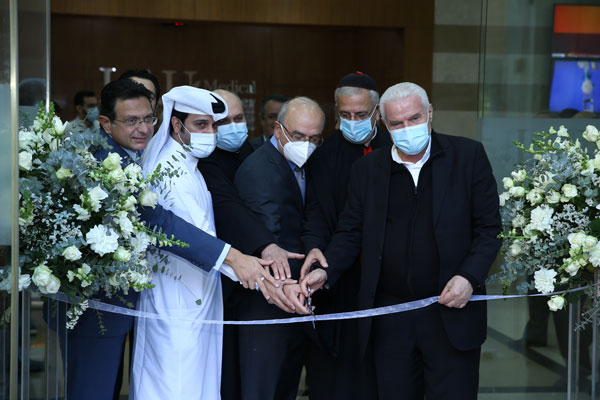
![[Photo]](https://100.lau.edu.lb/images/emil8550.jpg)
In the hope of mitigating the strain on the Lebanese health sector which was hit hard by the crisis and the brain drain of healthcare providers, LAU inaugurates a new health facility in the heart of Jounieh: the LAU Medical Center-Saint John’s Hospital. Together with LAU Medical Center-Rizk Hospital and the LAU Health Clinics, Dr. Mawad’s vision for a first-of-its-kind integrated health system is realized in Lebanon.
2021
—
2022
The return to campus after the pandemic is accompanied by Phase II of the LAU Emergency Financial Aid Fund against the backdrop of a worsening socioeconomic crisis. By 2022, LAU’s financial aid budget reaches $100 million, the largest such offering in Lebanon, covering close to 85 percent of the student body.
2022
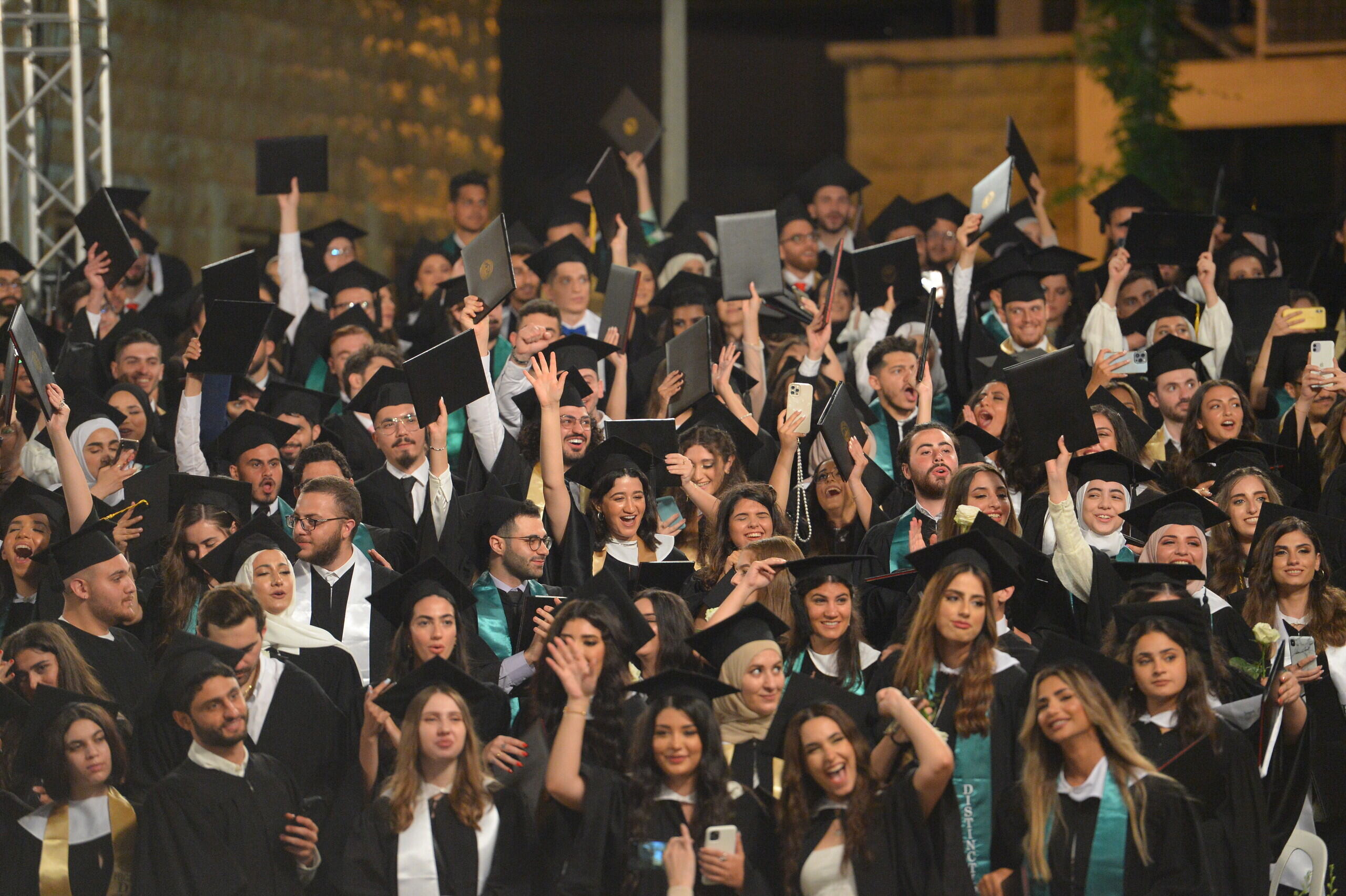
![[Photo]](https://100.lau.edu.lb/images/commencement2022-rdp5662.jpg)
Fulfilling its promise to hold in-person commencements for students who had graduated during the pandemic, LAU celebrates the achievements of the classes of 2020, 2021, along with 2022 in a record five ceremonies on the Beirut and Byblos campuses in one week.
2022
—
2023
Dr. Mawad sets in motion a series of initiatives that will contribute to the university’s continuity, impact and mission for the years to come, beginning with the move to expand beyond the geographical borders of Lebanon, such as transforming the New York Headquarters and Academic Center into a degree-granting micro campus and establishing online programs.
2023
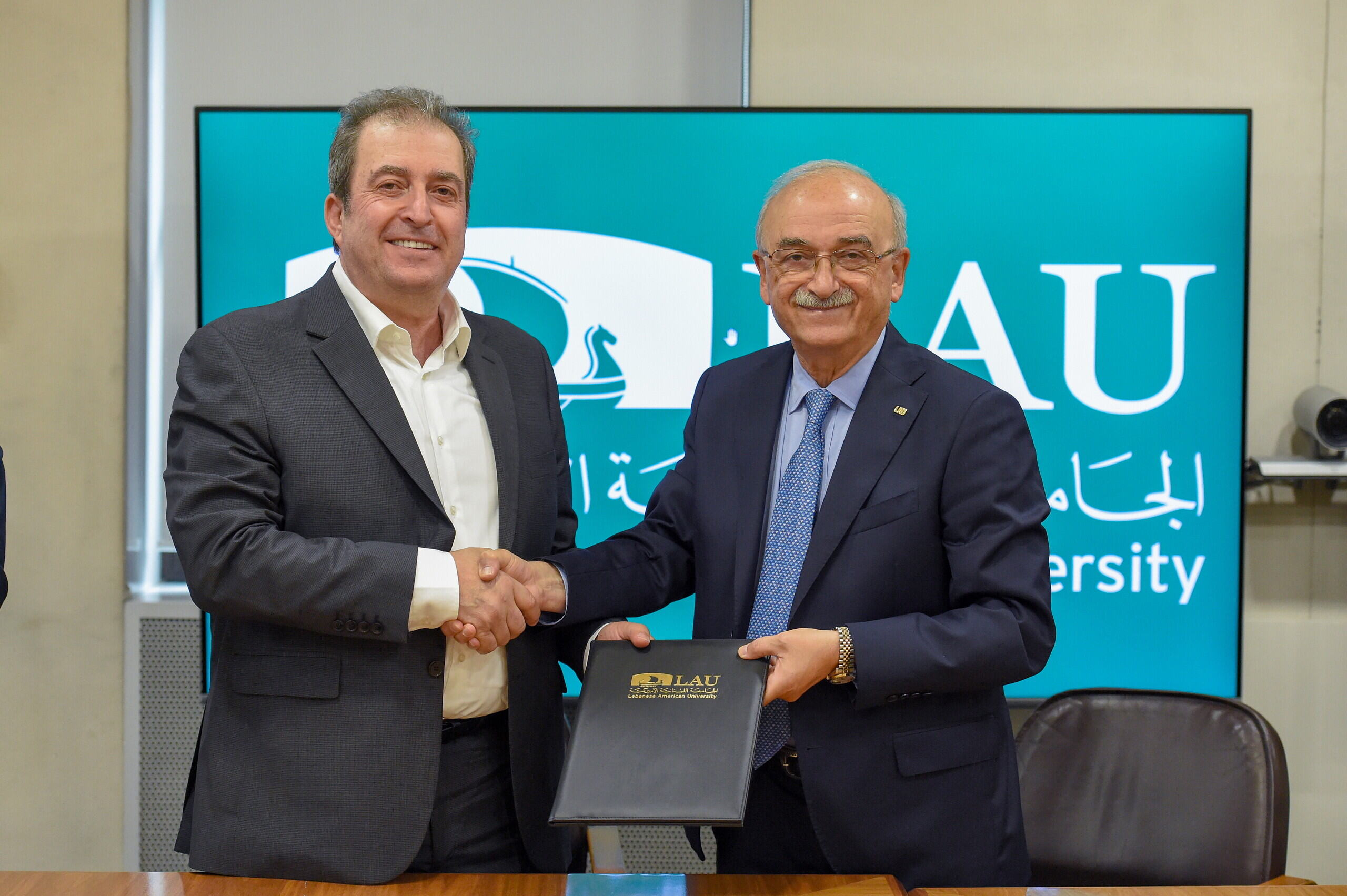
![[Photo]](https://100.lau.edu.lb/images/industrial-hub-mou-met-cs-pro024.jpg)
Dr. Mawad dedicates funds to bolster research and expands strategic partnerships to solidify industry-academia collaborations, which are formalized through the founding of the LAU Industrial Hub. In line with LAU’s long history of serving Lebanon, Dr. Mawad also sets up the Center for Policy Analysis, aiming to find solutions to nationwide challenges.
